Dreyfus affair
The Dreyfus Affair (French: l'affaire Dreyfus, pronounced [lafɛːʁ dʁɛfys]) was a political scandal that divided the Third French Republic from 1894 until its resolution in 1906. "L'Affaire", as it is known in French, has come to symbolise modern injustice in the Francophone world,[1] and it remains one of the most notable examples of a complex miscarriage of justice and antisemitism. The role played by the press and public opinion proved influential in the conflict.
| Part of a series on the |
| Dreyfus affair |
|---|
 Military degradation of Alfred Dreyfus |
| People |
The scandal began in December 1894 when Captain Alfred Dreyfus was convicted of treason. Dreyfus was a 35-year-old Alsatian French artillery officer of Jewish descent. He was sentenced to life imprisonment for allegedly communicating French military secrets to the German Embassy in Paris, and was imprisoned in Devil's Island in French Guiana, where he spent nearly five years.
In 1896, evidence came to light—primarily through an investigation instigated by Georges Picquart, head of counter-espionage—which identified the real culprit as a French Army major named Ferdinand Walsin Esterhazy. When high-ranking military officials suppressed the new evidence, a military court unanimously acquitted Esterhazy after a trial lasting only two days. The Army laid additional charges against Dreyfus, based on forged documents. Subsequently, Émile Zola's open letter J'Accuse…!, stoked a growing movement of support for Dreyfus, putting pressure on the government to reopen the case.
In 1899, Dreyfus was returned to France for another trial. The intense political and judicial scandal that ensued divided French society between those who supported Dreyfus (now called "Dreyfusards"), such as Sarah Bernhardt, Anatole France, Henri Poincaré and Georges Clemenceau, and those who condemned him (the anti-Dreyfusards), such as Édouard Drumont, the director and publisher of the antisemitic newspaper La Libre Parole. The new trial resulted in another conviction and a 10-year sentence, but Dreyfus was pardoned and released. In 1906, Dreyfus was exonerated and reinstated as a major in the French Army. He served during the whole of World War I, ending his service with the rank of lieutenant-colonel. He died in 1935.
The affair from 1894 to 1906 divided France into pro-republican, anticlerical, Dreyfusards and pro-Army, mostly Catholic "anti-Dreyfusards". It embittered French politics and encouraged radicalisation.[2]
Summary
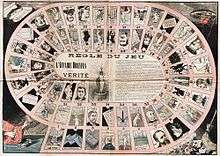
At the end of 1894 a French army captain named Alfred Dreyfus, a graduate of the École Polytechnique and a Jew of Alsatian origin, was accused of handing secret documents to the Imperial German military. After a closed trial, he was found guilty of treason and sentenced to life imprisonment. He was deported to Devil's Island. At that time, the opinion of the French political class was unanimously unfavourable towards Dreyfus.
The Dreyfus family, particularly his brother Mathieu, remained convinced of his innocence and worked with the journalist Bernard Lazare to prove it. In March 1896, Colonel Georges Picquart, head of counter-espionage, found evidence that the real traitor was Major Ferdinand Walsin Esterhazy. The General Staff, however, refused to reconsider its judgment and transferred Picquart to North Africa.
In July 1897 Dreyfus’s family contacted the President of the Senate Auguste Scheurer-Kestner to draw attention to the tenuousness of the evidence against Dreyfus. Scheurer-Kestner reported three months later that he was convinced Dreyfus was innocent, and persuaded Georges Clemenceau, a newspaper reporter and former member of the Chamber of Deputies. In the same month, Mathieu Dreyfus made a complaint about Esterhazy to the Ministry of War. In January 1898 two events raised the case to national prominence: Esterhazy was acquitted of treason charges (subsequently shaving his moustache and fleeing France), and Émile Zola published his "J'accuse...!" a Dreyfusard declaration that rallied many intellectuals to Dreyfus' cause. France became increasingly divided over the case, and the issue continued to be hotly debated until the end of the century. Antisemitic riots erupted in more than twenty French cities and there were several deaths in Algiers.
Despite covert attempts by the army to quash the case, the initial conviction was annulled by the Supreme Court after a thorough investigation. A new court-martial was held at Rennes in 1899. Dreyfus was convicted again and sentenced to ten years of hard labour, though the sentence was commuted due to extenuating circumstances. Dreyfus accepted the presidential pardon granted by President Émile Loubet. In 1906 his innocence was officially established by an irrevocable judgement of the Supreme Court.[3] Dreyfus was reinstated in the army with the rank of Major and participated in the First World War. He died in 1935.
The implications of this case were numerous and affected all aspects of French public life. It was regarded as a vindication of the Third Republic (and became a founding myth)[4], but it led to a renewal of nationalism in the military. It slowed the reform of French Catholicism and republican integration of Catholics. It was during The Affair that the term intellectual was coined. The Affair engendered numerous antisemitic demonstrations, which in turn affected sentiment within the Jewish communities of Central and Western Europe. This persuaded Theodor Herzl, one of the founding fathers of Zionism that the Jews must leave Europe and establish their own state.
Contexts
Political
In 1894, the Third Republic was twenty-four years old. Although the 16 May Crisis in 1877 had crippled the political influence of both the Bourbon and Orléanist royalists, its ministries continued to be short-lived as the country lurched from crisis to crisis: three immediately preceding the Dreyfus Affair were the near-coup of Georges Boulanger in 1889, the Panama scandal in 1892, and the anarchist threat (reduced by the "villainous laws" of July 1894). The elections of 1893 were focused on the "social question" and resulted in a Republican victory (just under half the seats) against the conservative right and the reinforcement of the Radicals (about 150 seats) and Socialists (about 50 seats).
The opposition of the Radicals and Socialists resulted in a centrist government with policies oriented towards economic protectionism, a certain indifference to social issues, a willingness to break international isolation, the Russian alliance, and development of the colonial empire. These centrist policies resulted in cabinet instability, with some Republican members of the government sometimes aligning with the radicals and some Orléanists aligning with the Legitimists in five successive governments from 1893 to 1896. This instability coincided with an equally unstable presidency: President Sadi Carnot was assassinated on 24 June 1894, his moderate successor Jean Casimir-Perier resigned on 15 January 1895 and was replaced by Félix Faure.
Following the failure of the radical government of Léon Bourgeois in 1896, the president appointed Jules Méline as prime minister. His government faced the opposition of the left and of some Republicans (including the Progressive Union) and made sure to keep the support of the right. He sought to appease religious, social, and economic tensions and conducted a fairly conservative policy. He succeeded in improving stability, and it was under this stable government that the Dreyfus Affair occurred.[5]
Military
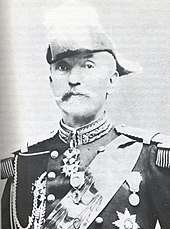
The Dreyfus Affair occurred in the context of the annexation of Alsace and Moselle by the Germans, an event that fed the most extreme nationalism. The traumatic defeat in 1870 seemed far away, but a vengeful spirit remained. Many participants in the Dreyfus Affair were Alsatian.[Note 1]
The military required considerable resources to prepare for the next conflict, and it was in this spirit that the Franco-Russian Alliance, which some saw as "against nature",[Note 2] of 27 August 1892 was signed. The army had recovered from the defeat but many of its officers were aristocrats and monarchists. Cult of the flag and contempt for the parliamentary republic prevailed in the army.[6] The Republic celebrated its army; the army ignored the Republic.
Over the previous ten years the army had experienced a significant shift in its twofold aim to democratize and modernize. The graduates of the École Polytechnique competed effectively with officers from the main career path of Saint-Cyr, which caused strife, bitterness, and jealousy among junior officers expecting promotions. The period was also marked by an arms race that primarily affected artillery. There were improvements in heavy artillery (guns of 120 mm and 155 mm, Models 1890 Baquet, new hydropneumatic brakes), but also and especially the development of the ultra-secret 75mm gun.[7]
The operation of military counterintelligence, alias the "Statistics Section" (SR), should be noted. Spying as a tool for secret war was a novelty as an organised activity in the late 19th century. The Statistics Section was created in 1871 but consisted of only a handful of officers and civilians. Its head in 1894 was Lieutenant-Colonel Jean Sandherr, a graduate of Saint-Cyr, an Alsatian from Mulhouse, and a convinced anti-Semite. Its military mission was clear: to retrieve information about potential enemies of France and to feed them false information. The Statistics Section was supported by the "Secret Affairs" of the Quai d'Orsay at the Ministry of Foreign Affairs, which was headed by a young diplomat, Maurice Paléologue. The arms race created an acute atmosphere of intrigue in French counter-espionage from 1890. One of the missions of the section was to spy on the German Embassy at Rue de Lille in Paris to thwart any attempt to transmit important information to the Germans. This was especially critical since several cases of espionage had already hit the headlines of newspapers, which were fond of sensationalism. Thus in 1890 the archivist Boutonnet was convicted for selling plans of shells that used melinite.
The German military attaché in Paris in 1894 was Count Maximilian von Schwartzkoppen, who developed a policy of infiltration which appears to have been effective. In the 1880s Schwartzkoppen had begun an affair with an Italian military attache, Lieutenant Colonel Count Alessandro Panizzardi.[8] While neither had anything to do with Dreyfus, their intimate and erotic correspondence (e.g. "Don't exhaust yourself with too much buggery."),[9] which was obtained by the authorities, lent an air of truth to other documents that were forged by prosecutors to lend retroactive credibility to Dreyfus's conviction as a spy. Some of these forgeries even referenced the real affair between the two officers; in one, Alessandro supposedly informed his lover that if "Dreyfus is brought in for questioning", they must both claim that they "never had any dealings with that Jew. ... Clearly, no one can ever know what happened with him."[10] The letters, real and fake, provided a convenient excuse for placing the entire Dreyfus dossier under seal, given that exposure of the liaison would have 'dishonoured' Germany and Italy's military and compromised diplomatic relations. As homosexuality was, like Judaism, then often perceived as a sign of national degeneration, recent historians have suggested that combining them to inflate the scandal may have shaped the prosecution strategy.[11][12]
Since early 1894, the Statistics Section had investigated traffic in master plans for Nice and the Meuse conducted by an officer whom the Germans and Italians nicknamed Dubois.[Note 3] This is what led to the origins of the Dreyfus Affair.
Social
The social context was marked by the rise of nationalism and of antisemitism.
The growth of antisemitism, virulent since the publication of Jewish France by Édouard Drumont in 1886 (150,000 copies in the first year), went hand in hand with the rise of clericalism. Tensions were high in all strata of society, fueled by an influential press, which was virtually free to write and disseminate any information even if offensive or defamatory. Legal risks were limited if the target was a private person.
Antisemitism did not spare the military, which practiced hidden discrimination with the "cote d'amour" (a subjective assessment of personal acceptability) system of irrational grading, encountered by Dreyfus in his application to the Bourges School.[13] However, while prejudices of this nature undoubtedly existed within the confines of the General Staff, the French Army as a whole was relatively open to individual talent. At the time of the Dreyfus Affair there were an estimated 300 Jewish officers in the army (about 3 per cent of the total), of whom ten were generals.[14]
The popularity of the duel using sword or small pistol, sometimes causing death, bore witness to the tensions of the period. When a series of press articles in La Libre Parole[15] accused Jewish officers of "betraying their birth", the officers challenged the editors. Captain Crémieu-Foa, a Jewish Alsatian graduated from the Ecole Polytechnique, fought unsuccessfully against Drumont[Note 4][16] and against M. de Lamase, who was the author of the articles. Captain Mayer, another Jewish officer, was killed by the Marquis de Morès, a friend of Drumont, in another duel.
Hatred of Jews was now public and violent, driven by a firebrand (Drumont) who demonized the Jewish presence in France. Jews in metropolitan France in 1895 numbered about 80,000 (40,000 in Paris alone), who were highly integrated into society; an additional 45,000 Jews lived in Algeria. The launch of La Libre Parole with a circulation estimated at 200,000 copies in 1892,[17] allowed Drumont to expand his audience to a popular readership already enticed by the boulangiste adventure in the past. The antisemitism circulated by La Libre Parole, as well as by L’Éclair, Le Petit Journal, La Patrie, L'Intransigeant and La Croix, drew on antisemitic roots in certain Catholic circles.[18]
Origins of the case and the trial of 1894
The beginning: Acts of espionage
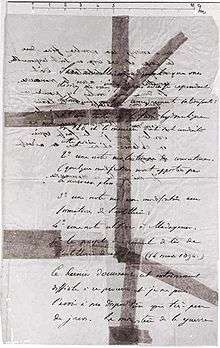
The origin of the Dreyfus Affair, although fully clarified since the 1960s,[19] has aroused much controversy for nearly a century. The intentions remain unclear.[Note 5] Many eminent historians express different hypotheses about the affair[Note 6] but all arrive at the same conclusion: Dreyfus was innocent of any crime or offence.
Discovery of the Bordereau
The staff of the Military Intelligence Service (SR) worked around the clock [20] to spy on the German Embassy in Paris. They had managed to hire a French housekeeper named "Madame Bastian" who worked in the building to help in this effort and in September 1894 she found a torn-up note[21] which she handed over to her employers at the Military Intelligence Service. This note later became known as "the bordereau".[Note 7] This piece of paper, torn into six large pieces,[22] unsigned and undated, was addressed to the German military attaché stationed at the German Embassy, Max von Schwartzkoppen. It stated that confidential French military documents regarding the newly developed "hydraulic brake of 120, and the way this gun has worked"[23][24] were about to be sent to a foreign power.
The search for the author of the bordereau
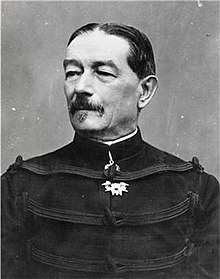
This catch seemed of sufficient importance for the head of the "Statistical Section",[25] the Mulhousian[26] Jean Sandherr, to inform the Minister of War, General Auguste Mercier. In fact the SR suspected that there had been leaks since the beginning of 1894 and had been trying to find the perpetrator. The minister had been harshly attacked in the press for his actions, which were deemed incompetent,[27] and appears to have sought an opportunity to enhance his image.[28][29] He immediately initiated two secret investigations, one administrative and one judicial. To find the culprit, using simple though crude reasoning,[30] the circle of the search was arbitrarily restricted to suspects posted to, or former employees of, the General Staff – necessarily a trainee artillery[Note 8] officer.[Note 9]
The ideal culprit was identified: Captain Alfred Dreyfus, a graduate of the École polytechnique and an artillery officer, of the Jewish faith and of Alsatian origin, coming from the republican meritocracy.[31] At the beginning of the case the emphasis was rather on the Alsatian origins of Dreyfus than on his religion. These origins were not, however, exceptional because these officers were favoured by France for their knowledge of the German language and culture.[32][33] There was also antisemitism in the offices of the General Staff,[34] and it fast became central to the affair by filling in the credibility gaps in the preliminary enquiry.[30] In particular, Dreyfus was at that time the only Jewish officer to be recently passed by the General Staff.
In fact, the reputation[35] of Dreyfus as a cold and withdrawn or even haughty character, as well as his "curiosity", worked strongly against him. These traits of character, some false, others natural, made the charges plausible by turning the most ordinary acts of everyday life in the ministry into proof of espionage. From the beginning a biased and one-sided multiplication of errors led the State to a false position. This was present throughout the affair, where irrationality prevailed over the positivism in vogue in that period:[36]
From this first hour the phenomenon occurred that will dominate the whole affair. It is no longer controlled by facts and circumstances carefully examined which will constitute a belief; it is the irresistible cavalier conviction which distorts the facts and beliefs.
Expertise in writing
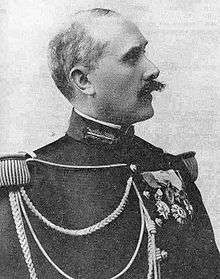
To condemn Dreyfus, the writing on the bordereau had to be compared to that of the Captain. There was nobody competent to analyse the writing on the General Staff.[37] Then Major du Paty de Clam[38][39] entered the scene: an eccentric man who prided himself on being an expert in graphology. On being shown some letters by Dreyfus and the bordereau on 5 October, du Paty concluded immediately who had written the two writings. After a day of additional work he provided a report that, despite some differences, the similarities were sufficient to warrant an investigation. Dreyfus was therefore "the probable author" of the bordereau in the eyes of the General Staff.[40]
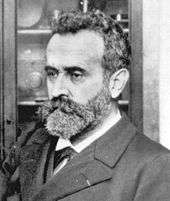
General Mercier believed he had the guilty party, but he exaggerated the value of the affair, which took on the status of an affair of state during the week preceding the arrest of Dreyfus. The Minister did consult and inform all the authorities of the State,[41] yet despite prudent counsel[Note 10] and courageous objections expressed by Gabriel Hanotaux in the Council of Ministers[42] he decided to pursue it.[43] Du Paty de Clam was appointed Judicial Police Officer to lead an official investigation.
Meanwhile several parallel sources of information were opening up, some on the personality of Dreyfus, others to ensure the truth of the identity of the author of the bordereau. The expert[Note 11] Gobert was not convinced and found many differences. He even wrote that "the nature of the writing on the bordereau excludes disguised handwriting".[44] Disappointed, Mercier then called in Alphonse Bertillon, the inventor of forensic anthropometry but no handwriting expert. He was initially no more positive than Gobert but he did not exclude the possibility of its being the writing of Dreyfus.[45] Later, under pressure from the military,[46] he argued that Dreyfus had autocopied it and developed his theory of "autoforgery".
The arrest
On 13 October 1894, without any tangible evidence and with an empty file, General Mercier summoned Captain Dreyfus for a general inspection in "bourgeois clothing", i.e. in civilian clothes. The purpose of the General Staff was to obtain the perfect proof under French law: a confession. That confession was to be obtained by surprise – by dictating a letter based on the bordereau[47][48] to reveal his guilt.
In the morning of 15 October 1894 Captain Dreyfus underwent this ordeal but admitted nothing. Du Paty even tried to suggest suicide by placing a revolver in front of Dreyfus, but he refused to take his life, saying he "wanted to live to establish his innocence". The hopes of the military were crushed. Nevertheless Du Paty de Clam still arrested the captain,[49] accused him of conspiring with the enemy, and told him that he would be brought before a court-martial. Dreyfus was imprisoned at the Cherche-Midi prison in Paris.[50]
The enquiry and the first military court
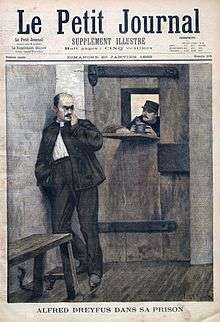
Mrs. Dreyfus was informed of the arrest the same day by a police raid to search their apartment. She was terrorized by Du Paty, who ordered her to keep the arrest of her husband secret and even said, "One word, one single word and it will be a European war!"[51] Totally illegally,[52] Dreyfus was placed in solitary confinement in prison, where Du Paty interrogated him day and night in order to obtain a confession, which failed. The captain was morally supported by the first Dreyfusard, Major Forzinetti, commandant of the military prisons of Paris.
On 29 October 1894, the affair was revealed in an article in La Libre Parole, the antisemitic newspaper owned by Édouard Drumont. This marked the beginning of a very brutal press campaign until the trial. This event put the affair in the field of antisemitism where it remained until its conclusion.[53]
On 1 November 1894, Alfred's brother, Mathieu Dreyfus, became aware of the arrest after being called urgently to Paris. He became the architect of the arduous fight for the liberation of his brother.[54] Without hesitation, he began looking for a lawyer, and retained the distinguished criminal lawyer Edgar Demange.[55]
The enquiry
On 3 November 1894, General Saussier, the Military governor of Paris, reluctantly[56] gave the order for an enquiry. He had the power to stop the process but did not, perhaps because of an exaggerated confidence in military justice.[57] Major Besson d'Ormescheville, the recorder for the Military Court, wrote an indictment in which "moral elements" of the charge (which gossiped about the habits of Dreyfus and his alleged attendance at "gambling circles", his knowledge of German,[Note 12] and his "remarkable memory") were developed more extensively than the "material elements",[Note 13] which are rarely seen in the charge:
"This is a proof of guilt because Dreyfus made everything disappear".
The complete lack of neutrality of the indictment led to Émile Zola calling it a "monument of bias".[58]
On 4 December 1894, Dreyfus was referred to the first Military Court with this dossier. The secrecy was lifted and Demange could access the file for the first time. After reading it the lawyer had absolute confidence, as he saw the emptiness of the prosecution's case.[59] The prosecution rested completely on the writing on a single piece of paper, the bordereau, on which experts disagreed, and on vague indirect testimonies.
The trial: "Closed Court or War!"
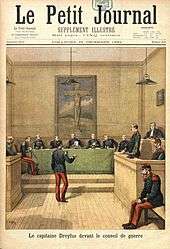
During the two months before the trial, the press went wild. La Libre Parole, L'Autorité, Le Journal, and Le Temps described the supposed life of Dreyfus through lies and bad fiction.[60] This was also an opportunity for extreme headlines from La Libre Parole and La Croix to justify their previous campaigns against the presence of Jews in the army on the theme "You have been told!"[61] This long delay above all enabled the General Staff to prepare public opinion and to put indirect pressure on the judges.[62] On 8 November 1894, General Mercier declared Dreyfus guilty in an interview with Le Figaro.[63] He repeated himself on 29 November 1894 in an article by Arthur Meyer in Le Gaulois, which in fact condemned the indictment against Dreyfus and asked, "How much freedom will the military court have to judge the defendant?"[64]
The jousting of the columnists took place within a broader debate about the issue of a closed court. For Ranc and Cassagnac, who represented the majority of the press, the closed court was a low manoeuvre to enable the acquittal of Dreyfus, "because the minister is a coward". The proof was "that he grovels before the Prussians" by agreeing to publish the denials of the German ambassador in Paris.[65] In other newspapers, such as L’Éclair on 13 December 1894: "the closed court is necessary to avoid a casus belli"; while for Judet in Le Petit Journal of 18 December: "the closed court is our impregnable refuge against Germany"; or in La Croix the same day: it must be "the most absolute closed court".[66]
The trial opened on 19 December 1894 at one o'clock[67] and a closed court was immediately pronounced.[Note 14] This closed court was not legally consistent since Major Picquart and Prefect Louis Lépine were present at certain proceedings in violation of the law. The closed court allowed the military to still not disclose the emptiness of their evidence to the public and to stifle debate.[68][69] As expected, the emptiness of their case appeared clearly during the hearings. Detailed discussions on the bordereau showed that Captain Dreyfus could not be the author.[70][71] At the same time the accused himself protested his innocence and defended himself point by point with energy and logic.[72] Moreover, his statements were supported by a dozen defence witnesses. Finally, the absence of motive for the crime was a serious thorn in the prosecution case. Dreyfus was indeed a very patriotic officer highly rated by his superiors, very rich and with no tangible reason to betray France.[73] The fact of Dreyfus's Jewishness was used only by the right-wing press and was not presented in court.
Alphonse Bertillon, who was not an expert in handwriting, was presented as a scholar of the first importance. He advanced the theory of "autoforgery" during the trial and accused Dreyfus of imitating his own handwriting, explaining the differences in writing by using extracts of writing from his brother Matthieu and his wife Lucie. This theory, although later regarded as bizarre and astonishing, seems to have had some effect on the judges.[74] In addition, Major Hubert-Joseph Henry made a theatrical statement in open court.[Note 15][75] He argued that leaks betraying the General Staff had been suspected to exist since February 1894 and that "a respectable person" accused Captain Dreyfus. He swore on oath that the traitor was Dreyfus, pointing to the crucifix hanging on the wall of the court.[76] Dreyfus was apoplectic with rage and demanded to be confronted with his anonymous accuser, which was rejected by the General Staff. The incident had an undeniable effect on the court, which was composed of seven officers who were both judges and jury. However, the outcome of the trial remained uncertain. The conviction of the judges had been shaken by the firm and logical answers of the accused.[77] The judges took leave to deliberate, but the General Staff still had a card in hand to tip the balance decisively against Dreyfus.
Transmission of a secret dossier to the judges

Military witnesses at the trial alerted high command about the risk of acquittal. For this eventuality the Statistics Section had prepared a file containing, in principle, four "absolute" proofs of the guilt of Captain Dreyfus accompanied by an explanatory note. The contents of this secret file remained uncertain until 2013, when they were released by the French Ministry of Defence.[78][79] Recent research indicates the existence of numbering which suggests the presence of a dozen documents. Among these letters were some of an erotic homosexual nature (the Davignon letter among others) raising the question of the tainted methods of the Statistics Section and the objective of their choice of documents.[80]
The secret file was illegally submitted at the beginning of the deliberations by the President of the Military Court, Colonel Émilien Maurel, by order of the Minister of War, General Mercier.[81] Later at the Rennes trial of 1899, General Mercier explained the nature of the prohibited disclosure documents submitted in the courtroom.[Note 16] This file contained, in addition to letters without much interest, some of which were falsified, a piece known as the "Scoundrel D ...".[82]
It was a letter from the German military attache, Max von Schwarzkoppen, to the Italian military attaché, Alessandro Panizzardi, intercepted by the SR. The letter was supposed to accuse Dreyfus definitively since, according to his accusers, it was signed with the initial of his name.[83] In reality, the Statistics Section knew that the letter could not be attributed to Dreyfus and if it was, it was with criminal intent.[84] Colonel Maurel confirmed in the second Dreyfus trial that the secret documents were not used to win the support of the judges of the Military Court. He contradicted himself, however, by saying that he read only one document, "which was enough".[85]
Conviction, degradation, and deportation

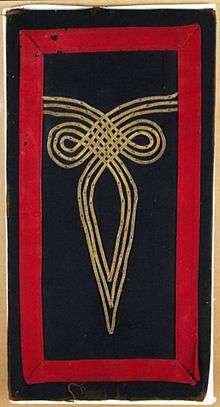
On 22 December 1894, after several hours of deliberation, the verdict was reached. Seven judges unanimously convicted Alfred Dreyfus of collusion with a foreign power, to the maximum penalty under section 76 of the Criminal Code: permanent exile in a walled fortification (prison), the cancellation of his army rank and military degradation. Dreyfus was not sentenced to death, as it had been abolished for political crimes since 1848.
For the authorities, the press and the public, doubts had been dispelled by the trial and his guilt was certain. Right and left regretted the abolition of the death penalty for such a crime. Antisemitism peaked in the press and occurred in areas so far spared.[87] Jean Jaurès regretted the lightness of the sentence in an address to the House and wrote, "A soldier has been sentenced to death and executed for throwing a button in the face of his corporal. So why leave this miserable traitor alive?" Clemenceau in Justice made a similar comment.[88]
On 5 January 1895, the ceremony of degradation took place in the Morlan Court of the Military School in Paris. While the drums rolled, Dreyfus was accompanied by four artillery officers, who brought him before an officer of the state who read the judgment. A Republican Guard adjutant tore off his badges, thin strips of gold, his stripes, cuffs and sleeves of his jacket. Witnesses report the dignity of Dreyfus, who continued to maintain his innocence while raising his arms: "Innocent, Innocent! Vive la France! Long live the Army". The Adjutant broke his sword on his knee and then the condemned Dreyfus marched at a slow pace in front of his former companions.[89] An event known as "the legend of the confession" took place before the degradation. In the van that brought him to the military school, Dreyfus is said to have confided his treachery to Captain Lebrun-Renault.[90][91] It appears that this was merely self-promotion by the captain of the Republican Guard, and that in reality Dreyfus had made no admission. Due to the affair's being related to national security, the prisoner was then held in solitary confinement in a cell awaiting transfer. On 17 January 1895, he was transferred to the prison on Île de Ré where he was held for over a month. He had the right to see his wife twice a week in a long room, each of them at one end, with the director of the prison in the middle.[92]

At the last minute, at the initiative of General Mercier, a law was passed on 9 February 1895, restoring the Îles du Salut in French Guiana, as a place of fortified deportation so that Dreyfus was not sent to Ducos, New Caledonia. Indeed, during the deportation of Adjutant Lucien Châtelain, sentenced for conspiring with the enemy in 1888, the facilities did not provide the required conditions of confinement and detention conditions were considered too soft. On 21 February 1895, he embarked on the ship Ville de Saint-Nazaire. The next day the ship sailed for French Guiana.
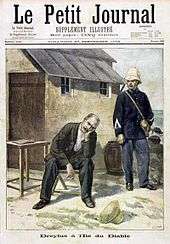
On 12 March 1895, after a difficult voyage of fifteen days, the ship anchored off the Îles du Salut. Dreyfus stayed one month in prison on Île Royale and was transferred to Devil's Island on 14 April 1895. Apart from his guards, he was the only inhabitant of the island and he stayed in a stone hut 4 by 4 metres (13 ft × 13 ft).[93] Haunted by the risk of escape, the commandant of the prison sentenced him to a hellish life, even though living conditions were already very painful.[Note 17] Dreyfus became sick and shaken by fevers that got worse every year.[94]
Dreyfus was allowed to write on paper numbered and signed. He underwent censorship by the commandant even when he received mail from his wife Lucie, whereby they encouraged each other. On 6 September 1896, the conditions of life for Dreyfus worsened again; he was chained double looped, forcing him to stay in bed motionless with his ankles shackled. This measure was the result of false information of his escape revealed by a British newspaper. For two long months, Dreyfus was plunged into deep despair, convinced that his life would end on this remote island.[95]
Truth on the march (1895–1897)
The Dreyfus family exposes the affair and takes action
Mathieu Dreyfus, the elder brother of Alfred, was convinced of his innocence. He was the chief architect of the rehabilitation of his brother and spent his time, energy and fortune to gather an increasingly powerful movement for a retrial in December 1894, despite the difficulties of the task:[96]
After the degradation emptiness was around us. It seemed to us that we were no longer human beings like others, we were cut off from the world of the living…[97]
Mathieu tried all paths, even the most fantastic. Thanks to Dr. Gibert, a friend of President Félix Faure, he met at Le Havre a woman who spoke for the first time under hypnosis of a "secret file".[98][99] This fact was confirmed by the President of the Republic to Dr. Gibert in a private conversation.
Little by little, despite threats of arrest for complicity, machinations and entrapment by the military, he managed to convince various moderates.[100] Thus the anarchist journalist Bernard Lazare looked into the proceedings. In 1896 Lazare published the first Dreyfusard booklet in Brussels.[101] This publication had little influence on the political and intellectual world, but it contained so much detail that the General Staff suspected that Picquart, the new head of SR, was responsible.
The campaign for the review, relayed little by little into the leftist anti-military press, triggered a return of a violent yet vague antisemitism.[102] France was overwhelmingly anti-Dreyfusard; Major Henry from the Statistics Section in turn was aware of the thinness of the prosecution case. At the request of his superiors, General Boisdeffre, Chief of the General Staff and Major-General Gonse, he was charged with the task of enlarging the file to prevent any attempt at a review. Unable to find any evidence, he decided to build some after the fact.
The discovery of the real culprit: Picquart "going to the enemy"
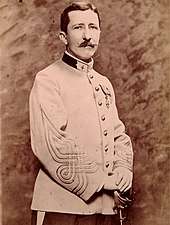
Major Georges Picquart was assigned to be head of the staff of the Military Intelligence Service (SR) in July 1895, following the illness of Colonel Sandherr. In March 1896, Picquart, who had followed the Dreyfus Affair from the outset, now required to receive the documents stolen from the German Embassy directly without any intermediary.[103][Note 18] He discovered a document called the "petit bleu": a telegram that was never sent, written by von Schwarzkoppen and intercepted at the German embassy at the beginning of March 1896.[104] It was addressed to a French officer, Major Walsin-Esterhazy, 27 rue de la Bienfaisance – Paris.[105] In another letter in black pencil, von Schwarzkoppen revealed the same clandestine relationship with Esterhazy.[106]
On seeing letters from Esterhazy, Picquart realized with amazement that his writing was exactly the same as that on the "bordereau", which had been used to incriminate Dreyfus. He procured the "secret file" given to the judges in 1894 and was astonished by the lack of evidence against Dreyfus, and became convinced of his innocence. Moved by his discovery, Picquart diligently conducted an enquiry in secret without the consent of his superiors.[107] The enquiry demonstrated that Esterhazy had knowledge of the elements described by the "bordereau" and that he was in contact with the German embassy.[108] It was established that the officer sold the Germans many secret documents, whose value was quite low.[109]
Ferdinand Walsin Esterhazy was a former member of French counterespionage where he had served after the war of 1870.[110] He had worked in the same office as Major Henry from 1877 to 1880.[111] A man with a personality disorder, a sulphurous reputation and crippled by debt, he was considered by Picquart to be a traitor driven by monetary reasons to betray his country.[112] Picquart communicated the results of his investigation to the General Staff, which opposed him under "the authority of the principle of res judicata". After this, everything was done to oust him from his position, with the help of his own deputy, Major Henry. It was primarily the upper echelons of the Army that did not want to admit that Dreyfus's conviction could be a grave miscarriage of justice. For Mercier, then Zurlinden and the General Staff, what was done was done and should never be returned to.[113] They found it convenient to separate the Dreyfus and Esterhazy affairs.
The denunciation of Esterhazy and the progress of Dreyfusism
The nationalist press launched a violent campaign against the burgeoning Dreyfusards. In counter-attack, the General Staff discovered and revealed the information hitherto ignored in the "secret file".[114] Doubt began to surface, and figures in the artistic and political spheres asked questions.[Note 19] Picquart tried to convince his seniors to react in favour of Dreyfus, but the General Staff seemed deaf. An investigation was started against him, he was monitored when he was in the east, then transferred to Tunisia "in the interest of the service".[115]
At this moment Major Henry chose to take action. On 1 November 1896, he created a false document, subsequently called the "faux Henry" [Henry forgery],[Note 20] keeping the header and signature[Note 21] of an ordinary letter from Panizzardi, and wrote the central text himself:
I read that a deputy will call on Dreyfus. If you ask further explanations from Rome, I would say that I never had relations with the Jew. That is understood. If asked, speak like that, because that person should never know what happened with him.
This was a rather crude forgery. Generals Gonse and Boisdeffre, however, without asking questions, brought the letter to their minister, General Billot. The doubts of the General Staff regarding the innocence of Dreyfus flew out the window.[116] With this discovery the General Staff decided to protect Esterhazy and persecute Colonel Picquart, "who did not understand anything".[116] Picquart, who knew nothing of the "faux Henry", quickly felt isolated from his fellow soldiers. Major Henry accused Picquart of embezzlement and sent him a letter full of innuendo.[117] He protested in writing and returned to Paris.
Picquart confided in his friend, lawyer Louis Leblois, who promised secrecy. Leblois, however, spoke to the vice president of the Senate, the Alsatian Auguste Scheurer-Kestner (born in Mulhouse, like Dreyfus), who was in turn infected by doubts. Without citing Picquart, the senator revealed the affair to the highest people in the country. The General Staff, however, still suspected Picquart of causing leaks. This was the beginning of the Picquart affair, a new conspiracy by the General Staff against an officer.[118]
Major Henry, although deputy to Picquart, was jealous and fostered his own malicious operation to compromise his superior.[119] He engaged in various malpractices (making a letter and designating it as an instrument of a "Jewish syndicate", wanting to help Dreyfus to escape, rigging the "petit bleu" to create a belief that Picquart erased the name of the real recipient, drafting a letter naming Dreyfus in full).
Parallel to the investigations of Picquart, the defenders of Dreyfus were informed in November 1897 that the identity of the writer of the "bordereau" was Esterhazy. Mathieu Dreyfus had a reproduction of the bordereau published by Le Figaro. A banker, Castro, formally identified the writing as that of Esterhazy, who was his debtor, and told Mathieu. On 11 November 1897, the two paths of investigation met during a meeting between Scheurer-Kestner and Mathieu Dreyfus. The latter finally received confirmation that Esterhazy was the author of the note. Based on this, on 15 November 1897 Mathieu Dreyfus made a complaint to the minister of war against Esterhazy.[120] The controversy was now public and the army had no choice but to open an investigation. At the end of 1897, Picquart returned to Paris and made public his doubts about the guilt of Dreyfus because of his discoveries. Collusion to eliminate Picquart seemed to have failed.[121] The challenge was very strong and turned to confrontation. To discredit Picquart, Esterhazy sent, without effect, letters of complaint to the president of the republic.[122]

The Dreyfusard movement, led by Bernard Lazare, Mathieu Dreyfus, Joseph Reinach and Auguste Scheurer-Kestner gained momentum.[123] Émile Zola, informed in mid-November 1897 by Scheurer-Kestner with documents, was convinced of the innocence of Dreyfus and undertook to engage himself officially.[Note 22] On 25 November 1897 the novelist published Mr. Scheurer-Kestner in Le Figaro, which was the first article in a series of three.[Note 23] Faced with threats of massive cancellations from its readers, the paper's editor stopped supporting Zola.[124] Gradually, from late-November through early-December 1897, a number of prominent people got involved in the fight for retrial. These included the authors Octave Mirbeau (his first article was published three days after Zola)[125] and Anatole France, academic Lucien Lévy-Bruhl, the librarian of the École normale supérieure Lucien Herr (who convinced Léon Blum and Jean Jaurès), the authors of La Revue Blanche,[Note 24] (where Lazare knew the director Thadee Natanson), and the Clemenceau brothers Albert and Georges. Blum tried in late November 1897 to sign, with his friend Maurice Barrès, a petition calling for a retrial, but Barrès refused, broke with Zola and Blum in early-December, and began to popularize the term "intellectuals".[126] This first break was the prelude to a division among the educated elite after 13 January 1898.
The Dreyfus Affair occupied more and more discussions, something the political world did not always recognize. Jules Méline declared in the opening session of the National Assembly on 7 December 1897, "There is no Dreyfus affair. There is not now and there can be no Dreyfus affair."[127]
Trial and acquittal of Esterhazy
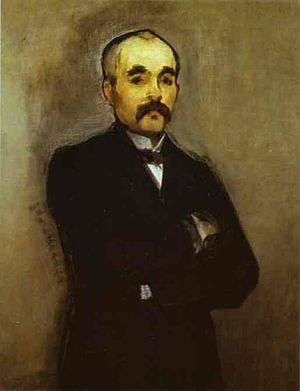
General Georges-Gabriel de Pellieux was responsible for conducting an investigation. It was brief, thanks to the General Staff's skillful manipulation of the investigator. The real culprit, they said, was Lieutenant-Colonel Picquart.[128] The investigation was moving towards a predictable conclusion until Esterhazy's former mistress, Madame de Boulancy, published letters in Le Figaro in which ten years earlier Esterhazy had expressed violently his hatred for France and his contempt for the French army. The militarist press rushed to the rescue of Esterhazy with an unprecedented antisemitic campaign. The Dreyfusard press replied with strong new evidence in its possession. Georges Clemenceau, in the newspaper L'Aurore, asked, "Who protects Major Esterhazy? The law must stop sucking up to this ineffectual Prussian disguised as a French officer. Why? Who trembles before Esterhazy? What occult power, why shamefully oppose the action of justice? What stands in the way? Why is Esterhazy, a character of depravity and more than doubtful morals, protected while the accused is not? Why is an honest soldier such as Lieutenant-Colonel Picquart discredited, overwhelmed, dishonoured? If this is the case we must speak out!"
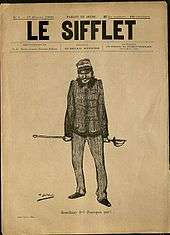
Although protected by the General Staff and therefore by the government, Esterhazy was obliged to admit authorship of the Francophobe letters published by Le Figaro. This convinced the Office of the General Staff to find a way to stop the questions, doubts, and the beginnings of demands for justice. The idea was to require Esterhazy to demand a trial and be acquitted, to stop the noise and allow a return to order. Thus, to finally exonerate him, according to the old rule Res judicata pro veritate habetur,[Note 25] Esterhazy was set to appear before a military court on 10 January 1898. A "delayed" closed court[Note 26] trial was pronounced. Esterhazy was notified of the matter on the following day, along with guidance on the defensive line to take. The trial was not normal: the civil trial Mathieu and Lucy Dreyfus[Note 27] requested was denied, and the three handwriting experts decided the writing in the bordereau was not Esterhazy's.[129] The accused was applauded and the witnesses booed and jeered. Pellieux intervened to defend the General Staff without legal substance.[130] The real accused was Picquart, who was dishonoured by all the military protagonists of the affair.[131] Esterhazy was acquitted unanimously the next day after just three minutes of deliberation.[132] With all the cheering, it was difficult for Esterhazy to make his way toward the exit, where some 1,500 people were waiting.

By error an innocent person was convicted, but on order the guilty party was acquitted. For many moderate Republicans it was an intolerable infringement of the fundamental values they defended. The acquittal of Esterhazy therefore brought about a change of strategy for the Dreyfusards. Liberalism-friendly Scheurer-Kestner and Reinach, took more combative and rebellious action.[133] In response to the acquittal, large and violent riots by anti-Dreyfusards and anti-Semites broke out across France.
Flush with victory, the General Staff arrested Picquart on charges of violation of professional secrecy following the disclosure of his investigation through his lawyer, who revealed it to Senator Scheurer-Kestner. The colonel, although placed under arrest at Fort Mont-Valérien, did not give up and involved himself further in the affair. When Mathieu thanked him, he replied curtly that he was "doing his duty".[132] The army declared Esterhazy unfit for service. To avoid personal risk he went into exile in England, where he lived comfortably and ended his days in the 1920s.[134] Esterhazy benefited from special treatment by the upper echelons of the army, which was inexplicable except for the General Staff's desire to stifle any inclination to challenge the verdict of the court martial that had convicted Dreyfus in 1894.
J'Accuse ...! 1898
The Dreyfus Affair becomes "The Affair"

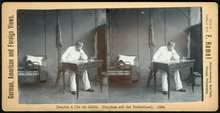
stereograph sold by F. Hamel, Altona-Hamburg...; collection Fritz Lachmund
On 13 January 1898 Zola touched off a new dimension in the Dreyfus Affair, which became known simply as The Affair. The first great Dreyfusard intellectual, Zola was at the height of his glory: the twenty volumes of the Rougon-Macquart epic were being distributed in dozens of countries. He was a leader in the literary world and was fully conscious of it. To General Pellieux, he said at his trial, "I ask General Pellieux if there are not many ways to serve France? It can be served by the sword or by the pen. General Pellieux has probably won great victories! I have won mine, too. By my work the French language has been brought into the world. I have my victories! I bequeath to posterity the name of General Pellieux and that of Émile Zola: history will choose![135]
Outraged by the acquittal of Esterhazy, Zola decided to strike a blow. He published a 4,500-word article on the front page of L'Aurore in the form of an open letter to President Félix Faure (Clemenceau thought up the headline J'Accuse…!). With a typical circulation of 30,000, the newspaper distributed nearly 300,000 copies that day. This article had the effect of an explosion. The article was a direct attack, explicit and clear, and named names. It denounced all those who had conspired against Dreyfus, including the minister of war and the General Staff. The article contained numerous errors, exaggerating or minimizing the roles of one or another of the figures involved (the role of General Mercier was greatly underestimated, for instance).[136]
J'Accuse…! provided for the first time a compilation of all existing data on the affair in one place.[137] Zola's goal was to make himself a target, to force the authorities to prosecute him. His trial forced a new public review of both the Dreyfus and Esterhazy affairs. Here he went against the strategy of Scheurer-Kestner and Lazare, who advocated patience and reflection.[138] Thanks to the national and international success of Zola's article, a trial became inevitable. From that critical moment the case followed two parallel paths. On one hand, the state used its apparatus to impose a limitation on the trial, restricting it to one of simple libel so as to separate the Dreyfus and Esterhazy cases, which had already been adjudicated. On the other hand, conflicting camps of opinion tried to influence judges and the government—one side pushed to obtain a review and the other to convict Zola. But Zola achieved his aim: the opening of a public debate at the Assize Court.
On 15 January 1898 Le Temps published a petition calling for a retrial.[139] It included the names of Émile Zola, Anatole France, director of the Pasteur Institute Émile Duclaux, Daniel Halévy, Fernand Gregh, Félix Fénéon, Marcel Proust, Lucien Herr, Charles Andler, Victor Bérard, François Simiand, Georges Sorel, the painter Claude Monet, the writer Jules Renard, the sociologist Émile Durkheim, and the historian Gabriel Monod.
On 20 January 1898, after an anti-Zola speech by rightist politician Albert de Mun at the Chamber of Deputies, the chamber voted 312–22 to prosecute Zola.[140] On 23 January 1898 Clemenceau, in the name of a "peaceful revolt of the French spirit", picked up the term "intellectuals" and used it in L'Aurore, but in a positive sense. On 1 February 1898 Barres lambasted the intellectuals in Le Journal. Anti-intellectualism became a major theme of right-wing intellectuals, who accused the Dreyfusards of failing to put the nation's interests first, an argument that continued throughout the years that followed and which became the basis of the public debate: a choice between justice and truth on the one hand, and the defense of the nation, preservation of society, and superiority of the state on the other.[141] At first, the political left did not echo this mobilization of intellectuals—on 19 January 1898 Socialist Deputies distanced themselves from the "two rival bourgeois factions".
The trial of Zola

General Billot, Minister of War, filed a complaint against Zola and Alexandre Perrenx, the manager of L'Aurore, to be heard at the Assises of the Seine from 7 to 23 February 1898. Defamation of a public authority was liable to trial in the Cour d'Assises, while insults to private figures—such as journalists and intellectuals—uttered by the nationalist and antisemitic press were limited to the civil adversarial system. (The taxpayer is at risk in the first case, while only the plaintiff is at risk in the second.) The minister referred to only three passages of Zola's article,[142] eighteen lines out of hundreds. He accused Zola of having written that the court martial had committed "unlawful acts [...] by order".[143] The trial opened in an atmosphere of extreme violence—Zola had been the object of "the most shameful attacks"[Note 28] as well as important support and congratulations.[Note 29]

Fernand Labori, Zola's lawyer, intended to call about 200 witnesses. The details of the Dreyfus Affair, unknown to most of the public, were published in the press. Several papers[Note 30] published shorthand notes verbatim of the debates every day to build support in the population. These notes were, for the Dreyfusards, an essential tool for later debates. The nationalists, behind Henri Rochefort, however, were more visible and organized riots, which forced the prefect of police to intervene to protect Zola whenever he left the facility[144] after every hearing.[145]
This trial was also the scene of a real legal battle in which the rights of the defence were constantly violated.[146] Many observers were aware of the collusion between France's political and military worlds. Evidently the court received instructions not to raise the subject of former judicial errors. President Delegorgue, on the pretext of the long duration of the hearings, juggled the law incessantly to ensure that the trial dealt only with the alleged defamation by Zola. Delegorgue's phrase "the question will not be put" was repeated dozens of times.[147]
- Labori: I beg your pardon, Mr. President, to intervene, but I would be interested to hear Messrs Couard, Belhomme and Varinard.
- President: No, no I have said ...
- Labori: But I have a question to put
- President : You will not put it.
- Labori: I insist Mr. President.
- President: I have told you, you may not put it.
- Labori: Oh! Mr. President! It is of interest...
- President: It is pointless to shout so loudly.
- Labori: I shout because I need to be heard.
- President : The question will not be put.
- Labori: I understand you have said that; but I said that I want to put it.
- President: Well! I say no, and it is a case already heard! The president has a right to dismiss this debate. All this prolongs the debate needlessly. It is my right to do this.
- Labori: You do not understand the question. You do not know what the question is.
- President: I know perfectly well what you are going to ask.
- Labori: Well, I have come to the conclusion that the court should be stopped at this point.
- President: Come to all the conclusions that you want.
- Labori: If you believe you can cut short the debate you deceive yourself.
- President: Well, we will decide on the findings during the recess
- (To the court bailiff): Another witness.
- (Mr. Auguste Molinier presents himself at the bar and takes the oath.)
- President: Has the witness been summoned in the normal way?
- Court Clerk: Yes, Mr. President.
- President: What is the question, Master Labori?
- Labori: I beg your pardon. I have written a finding, and I consider it absolutely essential that the testimony of Mr. Paul Meyer and the events described therein finish being discussed before the testimony of another witness. I do not need more than two minutes. I ask respectfully that you allow me to quickly question the witness.
- President: But this witness has been sworn; It is absolutely necessary that he be questioned now.
- Clemenceau: It is a question of two minutes.
- President: Ask your question now! It is useless to waste our time.
- Labori: I think that hearing Messrs Couard, Belhomme, and Varinard is essential to the truth and I maintain that the refusal of this order is recorded before the witness testifies: I consider it essential from the standpoint of the defence.
- (The President turns the pages in the Code of Criminal practice.)
- President to Mr. Molinier: Sir, would you please leave.
- (To the court bailiff): Would you remove this witness please.
- (Mr. Labori drew his conclusions)[148]
Zola was sentenced to one year in prison and a fine of 3,000 francs,[Note 31] which was the maximum penalty. This harshness was due to the atmosphere of violence surrounding the trial. "The excitement of the audience and the exasperation of the crowd in front of the courthouse were so violent that one could fear the worst excesses if the jury acquitted Mr. Zola".[149] However, the Zola trial was rather a victory for the Dreyfusards.[150] Indeed, the affair and its contradictions had been widely discussed throughout the trial, especially by the military. In addition, the violent attacks against Zola and the injustice of the conviction of Dreyfus reinforced the commitment of the Dreyfusards. Stéphane Mallarmé declared, "[I am] imbued by the admirable actions [of Zola]"[151] and Jules Renard wrote in his diary: "From tonight I hold on to the Republic that inspires respect in me, a tenderness in me that I do not know. I declare that Justice is the most beautiful word in the language of men and I must cry if men no longer understand it".[152] Senator Ludovic Trarieux and Catholic jurist Paul Viollet founded the League for the Defence of Human Rights. Even more than the Dreyfus Affair the Zola affair resulted in a regrouping of intellectual forces into two opposing camps.
On 2 April 1898 an application to the Supreme Court received a favourable response. This was the court's first intervention in the affair. The court upheld the appeal, on the formal grounds that as the alleged libel was against the military court, rather than the minister, it was the military court that should have made the complaint. Prosecutor-General Manau supported a review of the Dreyfus trial and strongly opposed the anti-Semites. The judges of the military court, whom Zola had challenged, therefore opened a new suit against him for libel. The case was brought before the Assizes of Seine-et-Oise in Versailles where the public was considered more favourable to the army and more nationalistic. On 23 May 1898, at the first hearing, Mr. Labori appealed to the Supreme Court regarding the change of jurisdiction, which adjourned the trial and postponed the hearing to 18 July 1898. Labori advised Zola to leave France for England before the end of the trial, which the writer did, departing for a one-year exile in England. The defendants were convicted again. As for Colonel Picquart, he found himself again in prison.
Henry unmasked, the case is rekindled
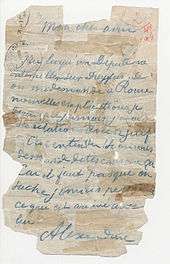
The acquittal of Esterhazy, the convictions of Émile Zola and of Georges Picquart, and the continued presence of an innocent man in prison had a considerable national and international effect.[153] France was exposed as an arbitrary state, which contradicted its founding republican principles. Antisemitism made considerable progress and riots were common throughout the year 1898. However politicians were still in denial about the affair. In April and May 1898, they were mostly concerned with elections, in which Jaurès lost his seat of Carmaux.[154] The majority was moderate, though a parliamentary group in the House was antisemitic. Nevertheless the cause of the Dreyfusards was restarted.
Godefroy Cavaignac, the new minister of war and a fierce supporter of anti-revisionism, definitely wanted to prove the guilt of Dreyfus and from there "wring the neck" of Esterhazy, whom he considered "a pathological liar and blackmailer".[155] He was absolutely convinced of Dreyfus's guilt, a conviction reinforced by the legend of the confession (after meeting the main witness, Captain Lebrun-Renault).[156] Cavaignac had the honesty of a doctrinaire intransigent,[157] but absolutely did not know the depths of the affair—the General Staff had kept him in the dark. He was surprised to learn that all the documents on which the prosecution was based had not been expertly appraised and that Boisdeffre had "absolute confidence" in Henry. Cavaignac decided to investigate—in his office, with his assistants—and retrieved the secret file, which now contained 365 items.[158]
On 4 April the newspaper Le Siècle published Lettre d'un Diplomate, the first of four documents, that were of critical importance in exposing Esterhazy's guilt, and enabled the Dreyfusard cause to regain the initiative it had lost with Zola's conviction. The secret information had been provided by Zola, who had received it from Oscar Wilde; Wilde had gained it from best friend Carlos Blacker, who was an intimate friend of Alexandro Panizzardi.[159][160]

On 7 July 1898 during a questioning in the House, Cavaignac reported three items "overwhelming among a thousand", two of which had no connection with the case. The other was the "faux Henry".[161] Cavaignac's speech was effective: the MPs gave him an ovation and voted to display copies of the three documents in the 36,000 communes of France.[162] The anti-Dreyfusards had triumphed, but Cavaignac implicitly recognized that the Dreyfus's defence had not had access to all the evidence. The application for annulment made by Lucie Dreyfus became admissible. The next day, Picquart declared in Le Temps to the council president, "I am in a position to establish before a court of competent jurisdiction that the two documents bearing the date of 1894 could not be attributed to Dreyfus and that the one that bears the date of 1896 had all the characteristics of a fake," which earned him eleven months in prison.
On the evening of 13 August 1898, Cuignet, who was attached to the cabinet of Cavaignac, was working by the light of a lamp and observed that the colour of the lines on the "faux Henry" paper header and footer did not correspond with the central part of the document. Cavaignac was still trying to find logical reasons for the guilt and conviction of Dreyfus[163] but was not silent on this discovery.[164] A board of inquiry was formed to investigate Esterhazy, before which he panicked and confessed his secret reports to Major du Paty de Clam. Collusion between the General Staff and the traitor was revealed. On 30 August 1898 Cavaignac resigned himself to demanding explanations from Colonel Henry in the presence of Boisdeffre and Gonse. After an hour of questioning by the minister himself, Henry broke down and made a full confession.[165] He was placed under arrest at the Mont-Valérien fortress, where he killed himself[166][167] the next day by cutting his own throat with a razor. The request for review filed by Lucie Dreyfus could not be rejected. Yet Cavaignac said "less than ever!",[168] but the president of the council, Henri Brisson, forced him to resign. Despite his apparently entirely involuntary role in the revision of the 1894 trial, Brisson remained convinced that Dreyfus was guilty and made a statement disparaging and offensive to Dreyfus at the Rennes trial.[169]
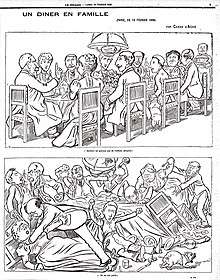
The anti-revisionists did not consider themselves beaten. On 6 September 1898 Charles Maurras published a eulogy of Henry in La Gazette de France in which he called him a "heroic servant of the great interests of the State".[170] La Libre Parole, Drumont's antisemitic newspaper, spread the notion of "patriotic fake" ("faux patriotique"). In December the same newspaper launched a subscription, in favour of his widow, to erect a monument to Henry. Each gift was accompanied by pithy, often abusive, remarks on Dreyfus and the Dreyfusards. Some 14,000 subscribers,[171] including 53 MPs, sent 131,000 francs.[172] On 3 September 1898, Brisson, the president of the council, urged Mathieu Dreyfus to file an application for review of the military court of 1894. The government transferred the case to the Supreme Court for its opinion on the past four years of proceedings.
France was really divided into two, but no more generalization is possible: the Jewish community was little involved, intellectuals were not all Dreyfusards,[Note 32] the Protestants were divided, and Marxists refused to support Dreyfus.[173] The split transcended religion and social background, as shown in a cartoon by Caran d'Ache A family dinner: before, "Above all, never talk about it !", after, "They talked about it".
Crisis and reshaping the political landscape
Henry was dead, Boisdeffre had resigned, Gonse had no more authority, and du Paty had been severely compromised by Esterhazy: for the conspirators it was a débâcle.[174] The government was now caught between two fires: the nationalist pressure on the street and the higher command. Cavaignac, having resigned for continuing to spread his anti-Dreyfusard vision of the Affair, arose as an anti-revisionist leader. General Zurlinden who succeeded him and was influenced by the General Staff, delivered a negative opinion at the review on 10 September 1898 comforting the extremist press by saying that, "a review means war". The obstinacy of the Government, who voted to revert to the Supreme Court on 26 September 1898, led to the resignation of Zurlinden who was soon replaced by General Chanoine.[175] When Chanoine was questioned in the House he handed in his resignation; trust was denied to Brisson and he was also forced to resign. Ministerial instability caused some governmental instability.
On 1 November 1898 the Progressive Charles Dupuy was appointed in place of Brisson. In 1894 he had covered the actions of General Mercier at the beginning of the Dreyfus Affair,[176] and four years later he announced that he would follow the judgment of the Supreme Court,[177] thus blocking the road for those who wanted to stifle the review and divest the Court. On 5 December 1898 in the shadow of a debate in the House on the transmission of the "secret file" to the Supreme Court the tension rose another notch. Insults, invective, and other nationalistic violence gave way to threats of an uprising. Paul Déroulède declared: "If there has to be a civil war so be it."[178]
A new crisis arose at the same time in the heart of the Supreme Court, since Quesnay de Beaurepaire, President of the Civil Chamber, accused the Criminal Chamber of Dreyfusism in the press. He resigned on 8 January 1899 as a hero of the nationalist cause. This crisis led to the divestiture of the Criminal Division in favour of joint chambers. This was the point of blockage for the review.[179]
In 1899 the affair took up more and more of the political scene. On 16 February 1899, Félix Faure, the President of France, died.[180] Émile Loubet was elected, which was an advance for the cause of the review as the previous president had been a fierce opponent. On 23 February 1899 at the funeral for Faure, Paul Déroulède attempted to force a coup at the Élysée Palace. It was a failure as it was not supported by the military. On 4 June 1899 Loubet was assaulted at the Longchamp Racecourse. These provocations plus permanent demonstrations from the extreme right, although it never actually put the Republic in danger, created a burst of Republicanism leading to the formation of a "government of republican defence" around Waldeck-Rousseau on 22 June 1899. The center of French politics, including Raymond Poincaré, had aligned itself with the pro-revisionists. The progressive anti-Dreyfusard Republicans such as Jules Méline, were rejected outright. The Dreyfus affair led to a clear reorganization of the French political landscape.[181]
The appeal on the judgment of 1894
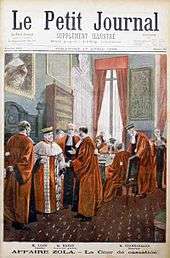
The Supreme Court considered the affair in the context of press campaigns against the Criminal Division, the magistrates being constantly dragged through the mud in nationalist newspapers from the Panama scandals.[182] On 26 September 1898, after a Cabinet vote, the Minister of Justice appealed to the Supreme Court. On 29 October 1898, after the submission of the report from the recorder Alphonse Bard, the Criminal Chamber of the Court stated that "the application is admissible and will proceed with a supplementary investigation".[183]
The recorder Louis Loew presided. He was subjected to a very violent campaign of antisemitic insults due to his being an Alsatian Protestant accused of being a deserter and tainted by the Prussians. Despite the compliant silence of Mercier, Billot, Zurlinden, and Roget, who hid behind the authority of "already judged" and "state secret", understanding of the affair increased. Cavaignac made a statement two days long, but failed to prove the guilt of Dreyfus. On the contrary, he unwittingly exonerated him by a demonstration of the exact date of the bordereau (August 1894).
Picquart then demonstrated all the workings of the error, then the conspiracy.[184] In a decision dated 8 December 1898 in response to his divestiture announcement, Picquart was protected from the military court by the Criminal Division of the Supreme Court.[185] This was a new obstacle to the wishes of the General Staff. A new furiously antisemitic press campaign burst during the event, while L'Aurore on 29 October 1898 published an article entitled Victory in the same character as J'accuse...![186] The work of the investigation was still to be taken back by the Criminal Division.[187] The "secret file" was analyzed from 30 December 1898 and the Criminal Division requested disclosure of diplomatic records, which was granted.
On 9 February 1899, the Criminal Division submitted its report by highlighting two important facts: it was certain Esterhazy used the same paper as the bordereau[Note 33] and the secret file was completely void. These two major events alone destroyed all proceedings against Alfred Dreyfus. In parallel, President Mazeau conducted an inquiry by the Criminal Division, which led to divestiture thereof "to not only leave it to bear alone all responsibility for the final decision," so protecting the Criminal Division from actions arising from its report.
On 28 February 1899, Waldeck-Rousseau spoke to the Senate on the floor and denounced "moral conspiracy" within the government and in the street. The review was no longer avoidable. On 1 March 1899, Alexis Ballot-Beaupré, the new President of the Civil Chamber of the Supreme Court, was appointed recorder for the consideration of the application for review. He took on the legal files and decided on a further investigation. Ten additional witnesses were interviewed, which further weakened the version of the General Staff. In the final discussion, President Ballot-Beaupré demonstrated the inanity of the bordereau, which was the only charge against Dreyfus. The prosecutor Manau echoed the views of the President. Mornard who represented Lucie Dreyfus argued without any difficulty or opposition from the prosecution.[188]
On 3 June 1899, the joint chambers of the Supreme Court overturned the judgment of 1894 in a formal hearing.[189] The case was referred to the Military Court of Rennes. By that judgment, the Supreme Court imposed itself as an absolute authority capable of standing up to military and political power.[190] For many Dreyfusards, this ruling was the prelude to the acquittal of the captain; they forgot to consider that it was again the army who would judge. The court, in overturning the judgement, believed in the legal autonomy of the military court without taking into account the laws of esprit de corps.[191]
The trial in Rennes 1899
Conduct of the trial
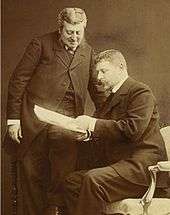
Alfred Dreyfus was in no way aware of what was happening thousands of kilometres from him. Neither was he aware of the schemes hatched to guarantee that he could never return, or the commitment of countless men and women to his cause. The prison administration filtered information deemed confidential. At the end of 1898, he learned with astonishment the actual size of the affair, about which he knew nothing: the accusation by his brother against Esterhazy, the acquittal of the traitor, Henry's confession and suicide, and the reading of the record of investigations of the Supreme Court, which he received two months after its publication.[192] On 5 June 1899 Alfred Dreyfus was notified of the decision of the Supreme Court on the judgement of 1894. On 9 June 1899 he left Devil's Island, heading to France, but locked in a cabin as if guilty, even though he no longer was. He disembarked on 30 June 1899 in Port Haliguen on the Quiberon peninsula in the greatest secrecy, "a clandestine and nocturnal return".[193] After five years of imprisonment, he was on his native soil, but he was immediately locked up from 1 July 1899 in the military prison in Rennes. He was remanded on 7 August 1899 before the military court of the Breton capital.
General Mercier, champion of the anti-Dreyfusards, intervened constantly in the press to confirm the accuracy of the first judgement: Dreyfus was surely guilty. Immediately, however, dissent emerged in the defence of Dreyfus. His two lawyers actually had opposing strategies. Demange wanted to stand on the defensive and just get the acquittal of Dreyfus. Labori, a brilliant lawyer who was just 35 years old, wanted to take the offensive, to aim higher and defeat and publicly humiliate the General Staff. Mathieu Dreyfus imagined a complementarity between the two lawyers. The conduct of the trial revealed the disunity that served the prosecution with a defence so impaired.

The trial opened on 7 August 1899 in an atmosphere of extreme tension. Rennes was in a state of siege.[194] The judges of the court-martial were under pressure. Esterházy, who admitted authorship of the bordereau, was in exile in England. He and du Paty were both excused. On the appearance of Dreyfus, emotions ran high. His physical appearance disturbed his supporters and some of his opponents.[Note 34] Despite his deteriorated physical condition, he had a complete mastery of the files acquired in only a few weeks.[195] All the General Staff testified against Dreyfus without providing any proof. They stubbornly considered null and void the confessions of Henry and Esterhazy. The trial even tended to go out of control to the extent that the decisions of the Supreme Court were not taken into account. They discussed in particular the bordereau, which was the proof of guilt of Esterhazy. Nevertheless Mercier was booed at the end of the hearing. The nationalist press and the anti-Dreyfusards could only speculate on his silence about the "conclusive evidence" (the pseudo-note annotated by the Kaiser, which nobody will ever see in evidence) that he had not ceased to report before the trial.

On 14 August 1899 Labori was on his way to court when he was shot in the back by an extremist who escaped and was never found. The lawyer was missing from discussions for over a week at the decisive moment of the examination of witnesses. On 22 August 1899 his condition had improved and he returned. Incidents between the two lawyers for Dreyfus multiplied. Labori reproached Demange about his excessive caution. The Government, in the face of the military hardening stance, still had two ways to influence events: call for testimony from Germany or abandon the charge.[196] These negotiations in the background, however, had no result. The German Embassy sent a polite refusal to the government. The Minister of War, General Gaston de Galliffet, sent respectful word to Major Louis Carrière, the government commissioner. He asked him to act in the spirit of the revised judgment of the Supreme Court. The officer pretended not to understand the allusion and helped the nationalist lawyer Auffray to make the indictment against Dreyfus. The defence needed to make a decision because the outcome of the case looked bad, despite evidence of the absence of charges against the accused. On behalf of the President of the Council, Pierre Waldeck-Rousseau, aided by Zola and Jaurès, Labori was convinced to give up his argument so as not to offend the military. They decided to risk conciliation in exchange for the acquittal that seemed to be promised by the government.[197] Mr. Demange, alone and without illusions, continued the defence of Dreyfus in an atmosphere of civil war. In Paris the antisemitic and nationalist agitators of Auteuil were arrested. Jules Guérin and those who fled and holed up in Fort Chabrol were assaulted by the police.
New conviction
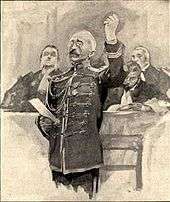
On 9 September 1899 the court rendered its verdict: Dreyfus was convicted of treason, but "with extenuating circumstances" (by five votes to two) and sentenced to ten years' imprisonment and a further degradation. Contrary to appearances, this verdict was on the verge of acquittal by one vote. The Code of Military Justice adopted the principle that a minority vote of three against four was an acquittal.[198]
The day after the verdict, Alfred Dreyfus, after much hesitation, filed an appeal for a retrial. Waldeck-Rousseau, in a difficult position, tackled for the first time the possibility of a pardon. Dreyfus had to accept guilt. Exhausted, having been away from his family for too long, he accepted. The decree was signed on 19 September 1899 and he was released on 21 September 1899. Many Dreyfusards were frustrated by this final act. Public opinion welcomed this conclusion indifferently. France wanted civil peace and harmony on the eve of the Universal Exhibition of 1900 and before the big fight that the Republic was about to take for freedom of association and secularism.
It was in this spirit that on 17 November 1899 Waldeck-Rousseau filed an amnesty law covering "all criminal acts or misdemeanours related to the Dreyfus affair or that have been included in a prosecution for one of these acts" excluding only Alfred Dreyfus himself who was instead pardoned to be able to still seek acquittal. Many Dreyfusards protested as this indemnified not only Zola and Picquart against (further) punishment but also protected the real culprits. Despite these massive protests the bill was passed.
Reactions

Reactions in France were strong, consisting of "shock and sadness" in the revisionist camp.[199] Still other reactions tended to show that the "verdict of appeasement" made by the judges was understood and accepted by the population. The Republicans sought above all social peace and to turn the page on this extremely long and controversial affair. Also there were very few demonstrations in the provinces while agitation persisted somewhat in Paris.[200] In the military world appeasement was also essential. Two of the seven judges voted for acquittal.[201] They refused to yield to the implied military order. This was also clearly seen. In an apostrophe for the army, Galliffet announced: "The incident is closed".
Anti-French demonstrations took place in twenty foreign capitals and the press was outraged.[202] Reactions were twofold. Norwegian composer Edvard Grieg cancelled his concerts in France in protest.[203] The British, as legalists, focused on espionage and challenged rather strongly this conviction devoid of positive arguments in its construction. As such the report of the Lord Chief Justice of England, Lord Russell of Killowen, on 16 September 1899, was a symbol of the global effect of the Affair in Great Britain. The English judge, who went as an observer to Rennes, criticised the weaknesses of the Military Court:
The Military judges were not familiar with the law or criminal proceedings. They lacked the experience and skill that can see the evidence behind the evidence. They were drowning in prejudice and they acted according to what they saw as the honour of the army. Impressed, full of respect for their superiors, they accorded too much importance to fragile allegations that were only made against the accused." Thus he concluded: "For surely it might have been predicted with certainty that, if the revision trial had taken place before the Cour de cassation ... Dreyfus would now be a free man.[204]
In Germany and Italy, the two countries widely challenged by lawsuits against Dreyfus, there was relief. Even if the Emperor of Germany regretted that the innocence of Dreyfus was not recognized the normalization of future Franco-German relations was seen as a welcome relaxation. Diplomacy of the three powers with the help of England sought to relax in an atmosphere that deteriorated again on the eve of the First World War.
This judicial conclusion also had an unfortunate consequence for the relationship between the Dreyfus family and the branch of ultra dreyfusists. Fernand Labori, Jaures, and Clemenceau, with the consent of Picquart openly accused Alfred Dreyfus of accepting the pardon and only gently protesting the amnesty law.[205]
Rehabilitation, 1900–1906
Preferring to avoid a third trial the government decided to pardon Dreyfus by a decree signed by President Émile Loubet on 19 September 1899 after much hesitation. Dreyfus was not found innocent. The rehabilitation process was not completed until six years later, when passions had cooled. Many books appeared during this period. In addition to the memoires of Alfred Dreyfus,[206] Reinach published his History of the Dreyfus Affair and Jaurès published The Proofs. As for Zola he wrote the third of his Gospels: Truth. Even Esterhazy took advantage of his secrets and sold several different versions of the text of his statement to the consul of France.[207]
Death of Zola
On 29 September 1902, Zola, who was the initiator of The Affair and the first of the intellectual Dreyfusards, died, asphyxiated by fumes from his chimney. His wife, Alexandrine, narrowly escaped.[208] It was a shock for the Dreyfusard clan. Anatole France, who demanded that Dreyfus be present at the funeral while the Chief of Police wanted his absence "to avoid problems", read his funeral oration for the author of "J'accuse...!

Before recalling the struggle undertaken by Zola for justice and truth is it possible for me to keep silent about those men bent on the destruction of an innocent man and who, after feeling lost, was saved and overwhelmed with the desperate audacity of fear?
How to depart from your sight then I have a duty to show you
Zola rises up weak and disarmed against them?
Can I hide their lies?
It would silence his heroic righteousness.
Can I hide their crimes?
That would conceal his virtue.
Can I silence the insults and calumnies which they have pursued?
It would silence his reward and honours.
Can I hide their shame?
It would silence his glory.
No, I will speak.
Envy him: he honoured his country and the world by a vast and a great act.
Envy him, his destiny and his heart gave out the greatest.
He was a moment of human conscience.
In 1953, the newspaper Liberation published a death-bed confession by a Parisian roofer that he had murdered Zola by blocking the chimney of his house.[209]
The semi-rehabilitation
Legal rehabilitation
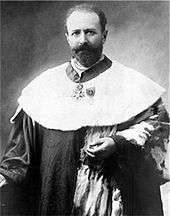
The elections of 1902 saw the victory of the left. Jean Jaurès was re-elected and he revived the Affair on 7 April 1903 while France thought the Affair buried forever. In a speech Jaurès evoked the long list of falsehoods peppering the Dreyfus case, and placed particular emphasis on two things, the letter of resignation from Pellieux, which was worded in very harsh terms. Legally, it formed an admission of the collusion of the General Staff,
[It] dupes people without honour [and] can no longer rely on the trust of subordinates, without which command is impossible. For my side I can not trust any of my chiefs who have been working on falsehoods, I ask for my retirement.
and the note allegedly annotated (by Kaiser Wilhelm II), which General Mercier had alluded to at the Rennes trial, which is reported by the press to have influenced the judges of the Military Court.[Note 35][210][211]
Given these developments, General Louis André, the new Minister of War, led an investigation at the instigation of Émile Combes and assisted by judges. The investigation was conducted by Captain Antoine Louis Targe, aide to the minister. During searches of the Statistics Section he discovered numerous documents, most of which were obviously fabricated.[212] In November 1903 a report was submitted to the Minister of Justice by the Minister of War. This was in compliance with the regulations since the Minister found an error committed by the Military Court. This was the beginning of a new review led by lawyer Ludovic Trarieux, the founder of the League of Human Rights, with a thorough investigation to run over two years. The years 1904 and 1905 were devoted to different legal phases before the Supreme Court. The court identified three events (grounds) for review, the demonstration of the falsification of the Panizzardi telegram, demonstration of a date change on a document in the 1894 trial (April 1895 changed to April 1894) and demonstration of the fact that Dreyfus had not removed the minutes related to heavy artillery in the army.
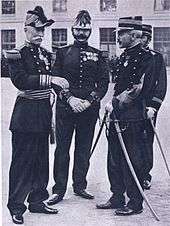
In regard to the writing of the bordereau the court was particularly severe against Alphonse Bertillon who "reasoned badly on forged documents". The report[Note 36] showed that the writing was certainly by Esterhazy and that the latter had also confessed subsequently. Finally the Court demonstrated by a comprehensive and skilled analysis of the bordereau the futility of this purely intellectual construction and a commission of four headed by a general of artillery, General Sebert, maintained "it is highly unlikely that an artillery officer could write this missive".[213]
On 9 March 1905 Attorney-General Baudouin delivered an 800-page report in which he demanded the convictions be quashed without further reference to another court and denounced the army. He began a divestiture of the military justice system, which did not conclude until 1982.[214] It was not until 12 July 1906 that the Supreme Court unanimously cancelled the judgment without reference to the military trial at Rennes in 1899 and pronounced "the end of the rehabilitation of Captain Dreyfus". The anti-Dreyfusards protested at this hasty rehabilitation. The goal was obviously political: it was to finish and finally turn the page. Nothing could dent the conviction of the opponents of Dreyfus. This method was the most direct and most definitive. What was annulled not only put a stop to Rennes, but the entire chain of prior acts, beginning with the arraignment order given by General Saussier in 1894. The Court focused on the legal aspects only and observed that Dreyfus did not have a duty to be returned before a Military Court for the simple reason that it should never have taken place due to the total absence of charges:
Whereas in the final analysis of the accusation against Dreyfus nothing remains standing and setting aside the judgment of the Military Court leaves nothing that can be considered to be a crime or misdemeanour; therefore by applying the final paragraph of Article 445 no reference to another court should be pronounced.
Subsequent career
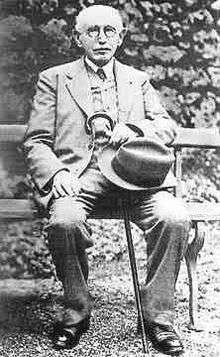
Dreyfus was reinstated in the army with the rank of artillery major by law on 13 July 1906. This reflected the rank to which he could reasonably have been expected to have risen had his career not been interrupted by the false charges against him.[215] However Dreyfus and his supporters were disappointed that his five years of imprisonment were not taken into account for the reconstruction of his career and that his promotion to major was back-dated only to 10 July 1903.[215] This decision blocked any hope of a career worthy of his past successes before his arrest in 1894. After serving for a year as commander of the artillery depot at Fort Neuf de Vincennes, Major Dreyfus retired in June 1907; a decision taken in part because of recurrent tropical fevers and chronic fatigue arising from the strain of his imprisonment.[216]
On 4 June 1908 on the occasion of the transfer of the ashes of Émile Zola to the Pantheon, Alfred Dreyfus was the target of an attack. Louis Grégori, an extreme right-wing journalist and assistant of Drumont, fired two shots from a revolver and wounded Dreyfus slightly in the arm. He was driven to do this for Action Française (French Action) not only to disrupt the ceremony for the "two traitors" Zola and Dreyfus, but also to remake the Dreyfus trial through a new trial, a revenge of some sort.[217] The trial was at the Assizes of the Seine, where Grégori was acquitted – the latest in a long series of judicial misconducts. It was an occasion for new antisemitic riots that the government suppressed half-heartedly.[218]
As a reserve officer Dreyfus participated in the First World War of 1914–1918, serving as head of the artillery depot at a fortified camp near Paris and commander of a supply column. In 1917 he saw frontline service at the Chemin des Dames and Verdun. Apart from Major Du Paty de Clam, Dreyfus was the only officer directly involved in the Affair to serve in the war.[219] Having been named as a Chevalier of the Legion of Honour at the time of his reinstatement in 1906, Dreyfus was promoted to the rank of officer of the Legion of Honour in 1919. His son, Pierre Dreyfus, also served in World War I as an artillery officer and was awarded the Croix de Guerre. Alfred Dreyfus's two nephews also fought as artillery officers in the French Army and both were killed. The same artillery piece (the Obusier de 120 mm C modèle 1890), the secrets of which Dreyfus was accused of revealing to the Germans, was among those used in blunting the early German offensives. He ended his military career as a colonel.[220]
Dreyfus died on 12 July 1935 at the age of seventy-five. His funeral cortège passed through ranks assembled for Bastille Day celebrations at the Place de la Concorde and he was buried in Montparnasse Cemetery. Colonel Picquart was also officially rehabilitated and reintegrated into the army with the rank of Brigadier general. Picquart was Minister of War from 1906 to 1909 in the first Clemenceau government; he died in January 1914 in a riding accident.[221]
Consequences of the Dreyfus Affair
For some the Dreyfus affair marked French society as a tortured society. All sections of society were affected; some were devastated.[222] According to Katrin Schultheiss, a modern historian:
The enduring significance of the Dreyfus Affair ... lies in its manifest embodiment of multiple narratives and multiple strands of historical causality. It shows how longstanding beliefs and tensions can be transformed ... into a juggernaut that alters the political and cultural landscape for decades. In the interest of increasing our understanding ... the complexities of that transformation should be recognized and analyzed rather than packaged for moral or political usefulness.[223]
Political consequences
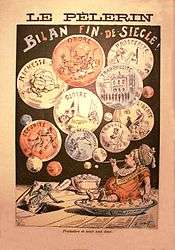
The Affair brought the confrontation between two sides of France to life.[224] However, according to most historians, this opposition served the republican order. There was indeed a strengthening of parliamentary democracy and a failure of monarchist and reactionary forces.
The excessive violence of the nationalist parties brought together Republicans in a united front, which defeated attempts to return to the old order.[225] In the short term, progressive political forces from the elections of 1893 and confirmed in 1898 as a result of the Dreyfus affair disappeared in 1899. The shock trials of Esterhazy and Zola created a dreyfusian politics whose aim was to develop a Republican consciousness and to fight against authoritarian nationalism, which expressed itself during the Affair. For the uninhibited growth of populist nationalism was another major result of the event in French politics even though it did not originate from the Dreyfus affair. It grew out of the Boulanger Affair, 1886–1889, and was shaped into a coherent theory by Maurice Barrès in 1892.[226] Nationalism had its ups and downs, but managed to maintain itself as a political force under the name of French Action, among others, until the defeat of 1940 when, after fifty years of struggle, it came to power and tried out the old dream of Drumont, "to purify" the state with the consequences that are well known. On that occasion many Republicans rallied to Vichy, without which the operation of the State would have been precarious, which showed the fragility of the republican institution in extreme circumstances.[227] Upon liberation, Charles Maurras who was convicted on 25 January 1945 for acts of collaboration exclaimed at the verdict: "This is the revenge of Dreyfus!"[228]
The other result was an intellectual mutation of socialism. Jaurès was a late Dreyfusard (January 1898) and was persuaded by revolutionary socialists.[229] His commitment became unwavering alongside Georges Clemenceau and from 1899 under the influence of Lucien Herr. The year 1902 saw the birth of two parties: the French Socialist Party, which brought together jaurésiens; and the Socialist Party of France under the influence of Guesde and Vaillant. Both parties merged in 1905 as the French Section of the Workers' International (SFIO).
In addition 1901 saw the birth of the Republican radical socialist Party, the first modern political party,[230] conceived as an electoral machine of the Republican group. It had a permanent structure and relied on networks of Dreyfusards. The creation of the French League for Human Rights was contemporaneous with the affair. It was the hub of the intellectual left and extremely active at the beginning of the century, the conscience of the humanist left.
The final consequence on the political scene at the turn of the century saw a profound renewal of political personalities with the disappearance of great republican figures beginning with Auguste Scheurer-Kestner. Those who at the end of the century could weigh heavily on the events of the affair had now disappeared giving way to new men whose ambition was to reform and correct the errors and injustices of the past.
Social consequences
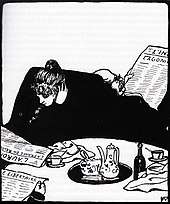
Socially antisemitism was prominent. Existing prior to the Dreyfus affair it had expressed itself during the boulangisme affair and the Panama Canal scandal but was limited to an intellectual elite. The Dreyfus Affair spread hatred of Jews through all strata of society, a movement that certainly began with the success of Jewish France by Édouard Drumont in 1886.[231] It was then greatly amplified by various legal episodes and press campaigns for nearly fifteen years. Antisemitism was from then on official and was exposed in numerous settings including the working classes.[232] Candidates for the legislative elections took advantage of antisemitism as a watchword in parliamentary elections. This antisemitism was reinforced by the crisis of the separation of church and state in 1905, which probably led to its height in France. Antisemitic actions were permitted on the advent of the Vichy regime, which allowed free and unrestrained expression of racial hatred.
Another social consequence was the enhanced role of the press. For the first time it exerted an important influence on French political life.[233] It was possible to speak of a fourth estate since it could act the part of all state organs.[234] Especially as the high editorial quality of the press was mainly derived from the work of writers and novelists who used newspapers as a revolutionary way of expression. The power of the press certainly brought politicians to action, an example of which was Mercier, who appeared to have pushed at the Dreyfus trial in 1894 to please La Libre Parole who attacked ferociously. This being said the role of the press was limited by the size of circulation, influential in Paris but to a lesser extent nationwide.[235] The entire run of the national press appeared to revolve around four and a half million copies whose real influence was relatively strong. There was also assistance through the publication in 1899 of a specific newspaper intended to coordinate the fight (in the dreyfusist camp), with the People's Daily of Sébastien Faure.
International consequences
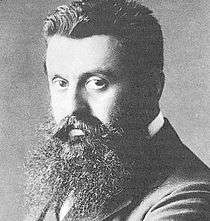
The Dreyfus affair created difficulties and blocked the way for improved relations between France and Italy after the customs war as Italy was Europe's most Dreyfusard nation.[236]
The shock of the Dreyfus Affair also affected the Zionist movement "which found fertile ground for its emergence".[237]
The Austro-Hungarian journalist Theodor Herzl appeared profoundly moved by the Dreyfus affair, which followed his debut as a correspondent for the Neue Freie Presse of Vienna and was present at the degradation of Dreyfus in 1895. "The Affair ... acted as a catalyst in the conversion of Herzl". Before the wave of antisemitism that accompanied the degradation Herzl was "convinced of the need to resolve the Jewish question", which became "an obsession for him". In Der Judenstaat (State of the Jews), he considered that:
[I]f France – bastion of emancipation, progress and universal socialism – [can] get caught up in a maelstrom of antisemitism and let the Parisian crowd chant 'Kill the Jews!' Where can they be safe once again – if not in their own country? Assimilation does not solve the problem because the Gentile world will not allow it as the Dreyfus affair has so clearly demonstrated ...[238]
Herzl's shock was great, for, having lived his youth in Austria, an antisemitic country, he chose to live in France for its humanist image, which made it appear a shelter from extremist excess. He had originally been a fanatic supporter for assimilation of Jews into European Gentile society. The Dreyfus Affair shook Herzl's view on the world, and he became completely enveloped in a tiny movement calling for the restoration of a Jewish State within the biblical homeland in Israel. Herzl quickly took charge in leading the movement.
He organized on 29 August 1897, the First Zionist Congress in Basel and is considered the "inventor of Zionism as a real political movement". Theodor Herzl wrote in his diary (1 September 1897):
Were I to sum up the Basel Congress in a word – which I shall guard against pronouncing publicly – it would be this: At Basel I founded the Jewish State. If I said this out loud today, I would be answered by universal laughter. Perhaps in five years, and certainly in fifty, everyone will recognize this.[239]
On 29 November 1947, a little over fifty years after the First Zionist Congress, the United Nations voted to partition Palestine into a Jewish State. The following year the state of Israel was established. Consequently, the Dreyfus Affair is seen as a turning point in Jewish history and as the beginning of the Zionist movement.
The Dreyfus affair also marked a turning point in the lives of many Jews from Western and Central Europe, as the pogroms of 1881–1882 had done for the Jews of Eastern Europe, as many Jews had believed that they were Frenchman first. Yet Jews, despite the state-sanctioned efforts of the emancipation movement, were never truly accepted into society and were often deemed aliens and outsiders,[240] even when they showed extreme devotion by fighting courageously in the wars of their respective countries.[16]
Other related events
Commission of sculpture
In 1985, President François Mitterrand commissioned a statue of Dreyfus by sculptor Louis Mitelberg. It was to be installed at the École Militaire but the Minister of Defense Charles Hernu refused to display it there.[241] Hernu claimed that this was because the École Militaire is not open to the public, but it was widely believed that this was done to avoid provoking the army.[242][243] It was instead installed at Boulevard Raspail, No. 116–118 at the exit of the Notre-Dame-des-Champs metro station, where it can be found today. A replica is located at the entrance of Paris's Museum of Jewish Art and History, housing the Fond Dreyfus, more than three thousand historical documents donated by the grandchildren of Captain Dreyfus.
Centennial commemoration
On 12 July 2006, President Jacques Chirac held an official state ceremony marking the centenary of Dreyfus's official rehabilitation. This was held in the presence of the living descendants of both Émile Zola and Alfred Dreyfus. The event took place in the same cobblestone courtyard of Paris's École Militaire where Capitaine Dreyfus had been officially stripped of his officer's rank. Chirac stated that "the combat against the dark forces of intolerance and hate is never definitively won", and called Dreyfus "an exemplary officer" and a "patriot who passionately loved France". The French National Assembly also held a memorial ceremony of the centennial marking the end of the Affair. This was held in remembrance of the 1906 laws that had reintegrated and promoted both Dreyfus and Picquart at the end of the Dreyfus affair.
Historiography of the Dreyfus Affair
.jpg)
The Dreyfus Affair is distinguished by the large number of books published on this subject.[244][245] [246]
All the official records are readily available including reports of all public hearings of the many trials in the Affair. In addition, a large number of records are easily accessible in the French National Archives and in the Military Archives at the fort of Vincennes. The contemporary literature of the case was published between 1894 and 1906. It began with the pamphlet of Bernard Lazare, the first intellectual Dreyfusard.
The Precis of the Dreyfus Affair by "Henri-Dutrait Crozon", a pseudonym of Colonel Larpent,[Note 37] is the basis of all anti-Dreyfusard literature after the Affair to the present time. The author develops the theory of conspiracy, fueled by Jewish finance, to push Esterhazy to accuse himself of crime. Under a scientific exterior there will be found there an elaboration of theories without evidence or support.
The publication of notes by Schwartzkoppen in 1930 shed light on the guilty role of Esterházy in the Affair and exonerated Alfred Dreyfus at the same time, if such vindication was needed. The extreme right questioned the value of this testimony but most historians hold it to be a valid source despite some ambiguities and inaccuracies.
The period of the Occupation throws a veil over the case. The Liberation and the revelation of the Holocaust brought a deep reflection on all of the Dreyfus Affair. Jacques Kayser (1946) then Maurice Paléologue (1955) and Henri Giscard d'Estaing (1960) revived the case without great revelations, a process generally considered insufficient historically.
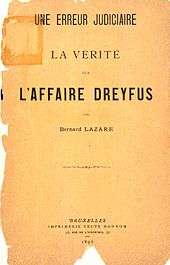
Marcel Thomas, chief curator at the National Archives, in 1961 provided through his The Affair without Dreyfus in two volumes a complete review of the history of the affair supported by all available public and private archives. His work is the foundation of all subsequent historical studies.[247]
Jean Doise, of the École Normale Supérieure and a military professional with a strong technical background attempts to explain the genesis of the case through the development, between 1892 and 1897, of the French 75mm field gun. Doise proposes in A Secret well guarded. Military History of the Dreyfus Affair that Alfred Dreyfus had been used by French counterintelligence to distract German espionage from the French 75's secret development and furthermore that Esterhazy, who once served in military counterintelligence, had played a role in this manipulation. These hypotheses are regarded with skepticism.
In 1983, the lawyer and historian Jean-Denis Bredin published L'Affair (The Affair)'’. The interest of the book focuses on a strictly factual relating of the story with documented facts and multifaceted reflection on the different aspects of the event. The book also revealed for the first time the existence of homosexual correspondence in the prosecution case.
Reflecting the intense interest in social history that gripped historians since the 1960s and 1970s, Eric Cahm wrote The Dreyfus Affair in French Society and Politics (1996), an analysis of the sociology of the Affair. Michael Burns, Rural Society and French Politics, Boulangism and the Dreyfus Affair, 1886–1900 (1984) does the same in a more limited fashion. Vincent Duclert's Biography of Alfred Dreyfus (2005) includes, in 1300 pages, the complete correspondence of Alfred and Lucie Dreyfus from 1894 to 1899.
Expanding on a 2008 article they published in la Revue d'histoire moderne et contemporaine, in 2012 the historians Pierre Gervais, Pauline Peretz and Pierre Stutin published Le dossier secret de l'affaire Dreyfus (The Secret Record of the Dreyfus Affair). Their research enabled the original contents of the secret file to be established. Their thesis was that historians had neglected the correspondence of Schwartzkoppen and Panizzardi, and that homosexuality played a central role in the slandering of Dreyfus.[11][12]
In addition the Dreyfus Affair provided the basis for many novels. The last work of Émile Zola (1902), Truth, transposes the Dreyfus affair to the world of education. Anatole France published The Island of Penguins (1907), which recounts the Affair in Book VI: "The Case of 80,000 bundles of hay".[248] Marcel Proust devoted significant passages of his second, third and fourth volumes of In Search of Lost Time to Parisian society's reaction to the Dreyfus affair. Other authors have also contributed, such as Roger Martin du Gard, Maurice Barrès, and Robert Harris.
Many artifacts and documents related to the affair are on display in the Musée d'Art et d'Histoire du Judaïsme in Paris.
Early writers marginalized the role of antisemitism. However since the publication of Jean-Denis Bredin, The Affair: The Case of Alfred Dreyfus (1986) and Stephen Wilson, Ideology and Experience: Antisemitism in France at the Time of the Dreyfus Affair (1982), more attention has been paid to the undercurrent of antisemitism in French society and its effect on the evolution of the case.[249]
See also
- Menahem Mendel Beilis affair
- Hilsner Affair
- Leo Frank affair
- Human Rights League (France)
- The Dreyfus Affair (film series), an 1899 series of short silent docudramas
- Musée d'Art et d'Histoire du Judaïsme
- Henry Ossian Flipper
Notes
- Dreyfus was from Mulhouse, as were Sandherr and Scheurer-Kestner, Picquart was from Strasbourg, Zurlinden was from Colmar.
- Auguste Scheurer-Kestner in a speech in the Senate.
- This was the purpose of the letter intercepted by the French SR called the "Scoundrel D ...", used in the "secret file" to convict Dreyfus
- Count Esterházy was, ironically, one of the witnesses for Crémieu-Foa
- Acute spy mania? Panic by the General Staff? Brainwashing of the French SR? Smokescreen for the development of ultra secret 75 mm gun?
- Hypotheses because the evidence does not exist.
- The French word bordereau [bɔʁ.də.ʁo] means simply a note or slip of paper and can be applied to any note. In French many documents in the case were called bordereaux; however, in this translation the term bordereau is used only for this note.
- On the indication of Captain Matton, the only artillery officer in the Statistics Section. Three of the documents transmitted concerned short- and long-range artillery.
- The documents could come from 1st, 2nd, 3rd or 4th offices – only a trainee appeared able to offer such a variety of documents as they passed from one office to another to complete their training. This was the reasoning of Lieutenant-Colonel d’Aboville, which proved fallacious.
- From General Saussier, Governor of Paris for example.
- Expert in writing from the Bank of France: his honest caution was vilified in the indictment of Major Ormescheville.
- "[...] he speaks several languages, especially German which he knows thoroughly."
- These are treated in the single penultimate paragraph in one sentence: "The material elements consist of the incriminating letter including review by the majority of experts as well as by us and by the witnesses who have seen it until now except for those who wilfully see differences, showing a complete similarity with the authentic writing of Captain Dreyfus".
- Trial takes place solely in the presence of judges, the accused, and his defence.
- Deputy Head of SR and discoverer of the bordereau.
- This was obviously wrong. The motive of Mercier was much to condemn Dreyfus unbeknownst to the defence. V. indictment.
- The temperature reached 45 °C, he was underfed or fed contaminated food and hardly had any treatment for his many tropical diseases.
- It was he who had been the captain on the morning of 15 October 1894 at the scene of the dictation.
- Cassagnac, though antisemitic, published an article entitled Doubt (in French) in mid-September 1896.
- Otherwise known as "faux patriotique" [patriotic forgery] by the anti-Dreyfusards.
- Alexandrine, Panizzardi's usual signature.
- "He had already intervened in Le Figaro in May 1896, in the article "For the Jews".
- According to the Syndicat of 1 December 1897 and the Minutes of 5 December 1897.
- At that time the heart of the artistic avant-garde, publishing Marcel Proust, Saint-Pol-Roux, Jules Renard, Charles Péguy, et al.
- "What is already judged is held to be true".
- The room is emptied as soon as discussion covers topics related to national defence, i.e., the testimony of Picquart.
- President Delegorgue refused to be questioned when he was called to the bar.
- He is treated as a stateless Italian immigrant.
- On 2 February, Octave Mirbeau, Laurent Tailhade, Pierre Quillard and Georges Courteline, among others, in L'Aurore signed an "Address to Émile Zola" assuring him of their support "in the name of justice and truth".
- Le Siecle and L’Áurore among others.
- Octave Mirbeau paid 7,525 francs from his own pocket, which represented the amount of the fine and court costs on 8 August 1898.
- Of the 40 members of the French Academy Anatole France was the only revisionist.
- The court did make several detailed scientific expert assessments to conclude with certainty.
- Maurice Barrès made a poignant description of Dreyfus.
- Faced with the evidence that the identity of the writer of the bordereau was Esterházy, the General Staff had spread the rumour that the bordereau was in fact copied from a note that was even commented in the handwriting of the German Emperor Wilhelm II. This allowed the people behind the rumours to explain the secrecy surrounding the whole affair, and the transmission of the "secret file" in 1894. Evidently, nobody ever found any evidence of these convenient assertions.
- Among the experts consulted, the contribution of the mathematician and physicist Henri Poincaré was noted.
- Inspired by Major Cuignet.
Sources
Book or article used as a source for writing this article
Primary sources
- 1898 (in French) Verbatim record of the trial of Emile Zola in the Assizes of the Seine and the Supreme Court.
- 1898 (in French) Enquiry of the Supreme Court (1898–1899).
- 1898 (in French) Proceedings of the Supreme Court for the revision of the Dreyfus trial.
- 1899 (in French) Verbatim record of the proceedings of Rennes Volume 1, Volume 2, Volume 3
- 1904 (in French) Memoire of Alfred Dreyfus to the Supreme Court.
- 1904 (in French) Enquiry of the Supreme Court.
- 1906 (in French) Debates of the Supreme Court.
- 1906 (in French) Decision of the Supreme Court for the verdict of the Dreyfus trial without reference to 1899.
- 2013 (in English) The Secret File, posted online by Ministry of Defence 6 March 2013 and transcription
Reference bibliography
- 1901 (in French) Joseph Reinach, History of the Dreyfus Affair, Fasquelle, 1901–1911; éd. Robert Laffont, two vol., 2006 231.
- 1961 (in French) Marcel Thomas, The Affair without Dreyfus, Fayard – Idégraf (Geneva), 1961–1979 – 2 volumes.
- 1981 (in French) Jean-Denis Bredin, The Affair, Fayard, Paris, 1993 (1ère édition 1981) (ISBN 2-260-00346-X).
- 1986 (in English) Jean-Denis Bredin, The Affair: the Case of Alfred Dreyfus, George Braziller, New York, ISBN 0-8076-1175-1 Plunkett Lake Press Ebooks
- 2005 (in French) Vincent Duclert, Biography of Alfred Dreyfus, The honour of a patriot, Fayard, Paris, 2006 (ISBN 2213627959).
Other general works
- McMillan, James F. Twentieth-Century France: Politics and Society in France 1898–1991 (1992) pp. 3–12
- Sowerwine, Charles. France since 1870: Culture, Society and the Making of the Republic (2001) excerpt and text search pp. 67–72
- 1984 (in English) Michael Burns, Rural Society and French Politics, Boulangism and the Dreyfus Affair, 1886–1900 Princeton University Press.
- 1991 (in English) Alfred S. Lindemann, The Jew Accused: Three Anti-Semitic Affairs, Dreyfus, Beilis, Frank, 1894–1914 (Cambridge University Press).
- 1992 (in English) Michael Burns, Dreyfus: A Family Affair, from the French Revolution to the Holocaust, New York: Harper.
- 1998 (in English) Michael Burns, France and the Dreyfus Affair: A Documentary History (Boston: Bedford/St. Martin's)
- 1996 (in English) Eric Cahm, The Dreyfus Affair in French Society and Politics New York: Longman
- 2006 (in English) George R. Whyte, The Accused – The Dreyfus Trilogy, Inter Nationes, ISBN 3-929979-28-4
- 2006 (in English) George R. Whyte, The Dreyfus Affair – A chronological history, Palgrave Macmillan 2006, ISBN 978-0-230-20285-6
- 2007 (in English) Ruth Harris, The Assumptionists and the Dreyfus Affair, Past & Present (2007) 194#1 175–211. in Project MUSE
- 2010 (in English) Ruth Harris, Dreyfus: Politics, Emotion, and the Scandal of the Century (Henry Holt and Company)
- 2008 (in French) Philippe Oriol, History of the Dreyfus Affair – Vol 1 – The History of Captain Dreyfus, Stock, (ISBN 978-2-234-06080-7)
- 2009 (in English) Louis Begley, Why the Dreyfus Affair Matters (Yale University Press)
- 2010 (in English) Frederick Brown, For the Soul of France: Culture Wars in the Age of Dreyfus (Alfred A. Knopf)
- 2012 (in English) Robert L. Fuller, The Origins of the French Nationalist Movement, 1886–1914, Jefferson, NC: McFarland.
- 2012 (in English) Piers Paul Read, The Dreyfus Affair, Bloomsbury, London
In French
- 1961 (in French) Pierre Miquel, The Dreyfus Affair, University of France Press – PUF – coll. "What do I know?", réprinted 2003 (ISBN 2130532268)
- 1989 (in French) Pierre Miquel, The Third Republic, Fayard
- 1986 (in French) Michel Winock, The fever of France. The great political crises. 1871–1968, Points Seuil, (ISBN 2020098318)
- 1999 (in French) Michel Winock, The School of Intellectuals, Le Seuil, coll. Points
- 1994 (in French) Pierre Birnbaum, The Dreyfus Affair, The Republic in peril, Gallimard, coll. "Discoveries", (ISBN 978-2070532773).
- 1994 (in French) Pierre Birnbaum, The France of the Dreyfus Affair, Gallimard, Paris
- 1998 (in French) Pierre Birnbaum, Was the French Army Antisemitic?, pp. 70–82 in Michel Winock: The Dreyfus Affair, Editions du Seuil, Paris, ISBN 2-02-032848-8
- 1994 (in French) Michael Burns, Histoire d'une famille française, les Dreyfus, Fayard, 1994 (ISBN 978-2213031323)
- 1994 (in French) Éric Cahm, The Dreyfus Affair, Päperback, coll. "references"
- 1994 (in French) Michel Drouin (dir.), The Dreyfus Affair Dictionary, Flammarion, reprinted 2006 (ISBN 2082105474).
- 1994 (in French) Vincent Duclert, The Dreyfus Affair, The Discovery, reprinted 2006 (ISBN 2707147931).
- 2006 (in French) Vincent Duclert, Dreyfus is Innocent: History of an Affair of State, Larousse, (ISBN 203582639X)
- 2006 (in French) Vincent Duclert, Alfred Dreyfus, Librairie Artheme Fayard, ISBN 2-213-62795-9
- 2010 (in French) Vincent Duclert, The Dreyfus Affair. When justice enlightens the Republic, Private
- 1999 (in English) Martin P. Johnson, The Dreyfus Affair: Honour and Politics in the Belle Epoque (New York: Palgrave Macmillan).
- 2000 (in French) Francis Démier, The France of the Nineteenth Century, Seuil, coll. "Points in History".
- 2006 (in French) Méhana Mouhou, Dreyfus Affair: conspiracy in the Republic, Éd. L'Harmattan.
- 2012 (in French) Pierre Gervais, Pauline Peretz et Pierre Stutin, The secret file of the Dreyfus Affair, Alma editor, (ISBN 978-2362790430)
Specialised works
- 1960 (in French) Patrice Boussel, The Dreyfus Affair and the Press, Armand Colin, coll. "Kiosk", 272 pp.
- 1962 (in French) Henri Guillemin, The Esterházy Enigma, Gallimard
- 1994 (in French) Jean Doise, A Secret well guarded – Military History of the Dreyfus Affair, Le Seuil, 225 pp. (ISBN 2-02-021100-9)
- 1998 (in French) Philippe-E. Landau, Jewish Opinion and the Dreyfus Affair, Albin Michel, "The Presence of Judaism", paperback
- 2000 (in French) Armand Israël, The hidden truth of the Dreyfus Affair, Albin Michel, (ISBN 2-226-11123-9)
- 2000 (in French) Collective, Intellectuals face the Dreyfus Affair, then and now, L'Harmattan, (ISBN 978-2738460257)
- 2004 (in French) Général André Bach, The Army of Dreyfus. A political history of the French army from Charles X to "The Affair", Tallandier, (ISBN 2-84734-039-4)
- 2006 (in French) Thierry Lévy, Jean-Pierre Royer, Labori, a lawyer, Louis Audibert Éditions, (ISBN 2-226-11123-9)
- 2006 (in French) Supreme Court, collective, Justice in the Dreyfus Affair, Fayard, (ISBN 978-2213629520)
- 2006 (in French) Pierre Touzin et Francois Vauvillier, Guns of Victory 1914–1918, Volume 1, The Artillery of the campaign. History and Collections, Paris. ISBN 2-35250-022-2
- 2010 (in French) Georges Joumas, Echos of the Dreyfus Affair for an Orléanais, Corsaire Éditions, (ISBN 978-2-910475-12-3)
- 2013 (in English) Leila Schneps and Coralie Colmez, Math on trial. How numbers get used and abused in the courtroom, Basic Books, 2013. ISBN 978-0-465-03292-1. (Chapter 10: "Math error number 10: mathematical madness. The Dreyfus affair: spy or scapegoat?").
Anti-Dreyfusard works
- 1909 (in French) Henri Dutrait-Crozon, Précis of the Dreyfus Affair, Paris, New National Library, First Editionmière, Final Edition 1924.
Articles and newspapers
- 1978 (in French) Dreyfusards!: Memories from Mathieu Dreyfus and other novelties (presented by Robert Gauthier). Gallimard & Julliard, coll. Archives No. 16, Paris
- 1988 (in French) Max Guermann, "The terrible truth", Revue Les Cahiers Naturalistes, No. 62.
- 1994 (in French) Revue in L'Histoire n o 173, Spécial Dreyfus, January 1994
- 2005 (in French) Special edition of Le Figaro on 12 July 2005, The centenary of the rehabilitation of Captain Dreyfus
- 2006 (in English) Kim Willsher (27 June 2006), "Calls for Dreyfus to be buried in Panthéon", The Guardian
- 2006 (in English) Ronald Schechter (7 July 2006), "The Ghosts of Alfred Dreyfus", The Forward.
- 2006 (in English) Stanley Meisler (9 July 2006), "Not just a Jew in a French jail", Los Angeles Times
- 2006 (in English) Adam Kirsch (11 July 2006), "The Most Shameful of Stains", The New York Sun
- 2007 (in French) Thomas Loué, "The Dreyfus Affair", in L. Boltanski et alii éds., Affairs, scandals, and great causes, Paris, Stock, pp. 213–227
- 2012 (in English) Schultheiss, Katrin. "The Dreyfus Affair and History", Journal of The Historical Society, 12 189–203. doi:10.1111/j.1540-5923.2012.00362.x
Testimonials
- 1898 (in French) Jean Jaurès, The Evidence, Collection of Articles appearing in La Petite République – available on Wikisource
- 1898 (in French) Alfred Dreyfus, Letters of an Innocent man, Stock
- 1901 (in English) Alfred Dreyfus, Five Years of My Life, French original „Cinq années de ma vie“ published in France in 1901, English translation first published in 1901, newest reprint 2019 (ISBN 978-3-945831-19-9).
- 1901 (in French) Alfred Dreyfus, Cinq années de ma vie, Eugène Fasquelle Éditeurs, Paris, 1901, reprinted 2006 (The Discovery) (ISBN 2707148067)
- 1898 (in French) Paschal Grousset, The Dreyfus Affair and its secret remits: a historical summary, ed Godet et Cie, Paris, 240 p.
- 1899 (in French) Paschal Grousset, The Dreyfus Affair, the word of an enigma. Paris, Stock.
- 1899 (in French) Georges Clemenceau, Towards Reparation, Tresse & Stock
- 1899 (in French) Georges Clemenceau, The Iniquity, Stock
- 1903 (in French) Georges Clemenceau, The Disgrace
- 1955 (in French) Maurice Paléologue, The Dreyfus Affair and the Quai d'Orsay, Plon
- 1978 (in French) Mathieu Dreyfus, The Affair that I have lived, Bernard Grasset, Paris. (ISBN 2-246-00668-6)
- 1991 (in French) Octave Mirbeau, The Dreyfus Affair, Librairie Séguier.
- 1993 (in French) Léon Blum, Memories of The Affair, Flammarion, Folio Histoire, (ISBN 978-2070327522)
- 2006 (in French) Émile Zola, Fight for Dreyfus. Preface by Martine Le Blond-Zola. Postscript by Jean-Louis Lévy. Presentation and notes d'Alain Pagès. Dilecta Edition.
Other reference material
Literature
- 1898 (in English) Poems written by Philadelphia poet Florence Earle Coates (1850–1927) about the affair:
- "Dreyfus" – published in Poet Lore (September 1898) and subsequently in Mine and Thine (1904).
- "Dreyfus" – a fugitive poem published in The Independent (16 February 1899).
- "Picquart" – published in The Century Magazine (July 1902) and subsequently in Mine and Thine (1904) and Poems Vol II.
- "Le Grand Salut" – published in The Living Age (25 August 1906) and subsequently in Lyrics of Life (1909) and Poems Vol II.
- 1908 (in French) Anatole France: A satirical take on the Dreyfus affair appears in Island of Penguins.
- 1913 (in French) Roger Martin du Gard: The Dreyfus affair occupies most of Martin du Gard's novel Jean Barois.
- 1922 (in French) Marcel Proust, The Dreyfus affair plays an important part in In Search of Lost Time, especially Vols. 3 and 4.
- 1994 (in English) The Dreyfus Centenary Committee, The Dreyfus Centenary Bulletin, London/Bonn.
- 1994 (in French) George Whyte, The Affair in Song; Bibliothèque de documentation internationale contemporaine; Paris, Flammarion.
- 1996 (in English) George Whyte, The Dreyfus Trilogy, Inter Nationes.
- 2006 (in English) George Whyte, The Dreyfus Affair, A Chronological History, Palgrave Macmillan.
- 2007 (in English) George Whyte. Admission is not Acceptance – Reflections on the Dreyfus Affair. Antisemitism. London Valentine Mitchell, 2007; Paris Editions Le Manuscript/Unesco 2008, Buenos Aires Lilmod 2009, Moscow Xonokoct 2010.
- 2009 (in English) A. S. Byatt, The Dreyfus Affair is mentioned several times in The Children's Book.
- 2010 (in English) Kate Taylor, A Man in Uniform.
- 2010 (in Italian) Umberto Eco, The Dreyfus Affair is woven into the plot of The Prague Cemetery.
- 2010 (in German) Peter Lang, Die Dreyfus Affäre – Die Macht des Vorurteils, Frankfurt, ISBN 978-3-631-60218-8
- 2011 (in English) The Dreyfus Affair – A Trilogy of Plays, Oberon Books, London, January 2011.
- 2013 (in English) Robert Harris, An Officer and a Spy, London: Hutchinson. 2013. ISBN 978-0-09-194455-1
Filmography
News and stories
- 1899 (in French) Dereliction of Duty in the Trial at Rennes – Sequence of images
- 1899 (in French) Mrs Dreyfus and her lawyer at the exit of the prison at Rennes – Sequence of images
- 1899 (in French) The Dreyfus Affair (reconstructed scenes, 11 episodes, 15 min) by Georges Méliès (a Dreyfusard) – DVD 2008 par Studio Canal
- 1899 (in French) The Dreyfus Affair (reconstructed scenes, 6 episodes) – Actualités Pathé
- 1902 (in French) The Dreyfus Affair – French film attributed to Ferdinand Zecca produced by Pathé
- 1907 (in French) The Dreyfus Affair – French film by Lucien Nonguet produced by Pathé
Documentaries
- 1965 (in French) The Dreyfus Affair, French film by Jean Vigne, made for schools – Black and White – 18 min
- 1972 (in English) The Dreyfus Affair, American Documentary Film – Black and White – 15 min
- 1974 (in French) Dreyfus or the Intolerable Truth, French Documentary Film by Jean Chérasse – Colour – 90 min – DVD 2006 by Alpamedia/Janus Diffusion
- 1994 (in French) Reasons of State: Chronicle of the Dreyfus Affair, French film in two episodes by Pierre Sorlin – Colour – 26 min
Cinema films
- 1899 (in English) Trial of Captain Dreyfus, American film – Black and White
- 1919 (in French) J'accuse, French silent film by Abel Gance – Black and White
- 1930 (in German) The Dreyfus Case, German Film by Richard Oswald – Black and White – 115 min
- 1931 (in English) The Dreyfus Case, English Film by F Kraemer and Milton Rosmer – Black and White – 90 min
- 1937 (in English) The Life of Émile Zola, American Film by William Dieterle – Black and White – 90 min
- 1958 (in English) I Accuse!, American film by José Ferrer – Black and White – 90 min
- 1960 (in Greek) I am innocent, Greek film by Dinos Katsouridis – Black and White – 90 min
- 2019 (in English) An Officer and a Spy - 2019 French film directed by Roman Polanski based on Harris' 2013 novel of the same name. [250][251]
TV films
- 1964 (in English) In the first season episode "Rock-a-Bye Munster", of the TV show The Munsters, Herman and Lilly mention meeting 'that charming Captain Dreyfus' on their honeymoon at Devil's Island.
- 1966 (in English) The Time Tunnel, episode "Devil's Island". Story in which Drs. Newman & Phillips encounter Captain Dreyfus, newly arrived on Devil's Island. ABC, broadcast on 11 November 1966.
- 1968 (in German) Affaire Dreyfus, German film in 3 episodes by ZDF[252]
- 1978 (in French) Zola or the Human Conscience, French film in four episodes by Stellio Lorenzi – Produced by Antenne 2 – Colour
- 1991 (in English) Can a Jew Be innocent?, English film in four episodes by Jack Emery – Produced by the BBC – Colour – 30 min (X4)
- 1991 (in English) Prisoner of Honour, American Film by Ken Russell – Colour – 88 min
- 1994 (in French) The Dreyfus Affair, French film in two episodes by Yves Boisset – Produced by France 2 – Colour
- 1994 (in French) Rage and Outrage, by George Whyte, French film – Produced by ARTE – Colour
- 1995 (in English) Dreyfus in Opera and Ballet, German and English film by arte – Produced by WDR – Colour
- 1995 (in German) Die Affäre Dreyfus, German film in two episodes by arte.[253]
Theatre
- 1895 (in English) Seymour Hicks wrote a drama titled One of the Best, based on the Dreyfus trial, starring William Terriss. It played at the Adelphi Theatre in London in 1895. The idea was suggested to Hicks by W. S. Gilbert.
- 1992 (in English) AJIOM/Captain Dreyfus, Musical. Music and text by George Whyte.
- 1994 (De En) The Dreyfus Trilogy by George Whyte (in collaboration with Luciano Berio, Jost Meier and Alfred Schnittke) comprising the opera Dreyfus-Die Affäre (Deutsche Oper Berlin, 8 May 1994; Theater Basle, 16 October 1994; The Dreyfus Affair New York City Opera, April 1996); the dance drama Dreyfus-J'accuse (Oper der Stadt Bonn, 4 September 1994) and the musical satire Rage et Outrage (Arte, April 1994; Zorn und Schande, Arte 1994; Rage and Outrage Channel 4, May 1994).
- 1998 (in English) Dreyfus: Prisoner of Devil's Island – Music Theatre piece – Music and Lyrics by Bryan Kesselman, St Giles Cripplegate, London, November 1998; Part of the 9th London international Jewish Music Festival.
- 2008 Dreyfus In time by George Whyte, Opernhaus Zurich, December 2008; Jüdisches Museum Berlin, May 2009. Also in German, English, French, Hungarian, Hebrew and Czech.
Radio
- 1995 (in French) The Dreyfus Affair, interview with George Whyte, France Culture, 25 March 1995.
- 1998 (in French) J'accuse, George Whyte, Canadian Broadcasting Service (CBS), 10 October 1998.
- 2005 (in English) The Dreyfus Affair, interview with George Whyte, BBC Radio 3. By John Pilgrim, 28 October 2005.
- 2009 (in English) BBC Radio, J'Accuse, UK, Hattie Naylor. Radio dramatisation inspired by a newspaper article written by Émile Zola in response to the Dreyfus Affair of the 1890s. BBC Radio 4, broadcast on 13 June 2009.
- 2009 (in English) "In Our Time, The Dreyfus Affair" Downloadable discussion on BBC Radio 4. Melvyn Bragg; Robert Gildea, Professor of Modern History at Oxford University; Ruth Harris, Lecturer in Modern History at Oxford University; Robert Tombs, Professor of French History at Cambridge University.[254]
- 2010 (in English) Interview with Ruth Harris about her book Dreyfus: Politics, Emotion, And the Scandal of the Century (2010).[255]
References
- Guy Canivet, first President of the Supreme Court, Justice from the Dreyfus Affair, p. 15.
- Daughton, James Patrick. (2006). An Empire Divided: Religion, Republicanism, and the making of French Colonialism, 1880-1914. Oxford Univ. Press. p. 8. ISBN 0-19-530530-2. OCLC 644094069.
- "Judgment of the Supreme Court on 12 July 1906" (PDF). Retrieved 5 August 2014.
- Michel Winock, "The Dreyfus Affair as a founding myth," in La France politique, Éditions du Seuil, coll. Points History, 2003, pp. 151–165. (in French)
- For these three paragraphs, cf. Jean-Marie Mayeur, The Beginnings of the Third Republic, Éditions du Seuil, 1973, pp. 209–217. (in French)
- Duclert, The Dreyfus Affair, p. 5. (in French)
- On the appearance of the 75 mm gun see: Doise, A Secret well guarded, p. 9. (in French)
- "Gay love sheds light on l'affaire Dreyfus | The Times". Retrieved 17 August 2016.
- "Trial of the Century". The New Yorker. Retrieved 17 August 2016.
- Weber, Caroline (13 March 2013). "Dreyfus, Proust and the Crimes of the Belle Epoque". Bloomberg View. Retrieved 17 August 2016.
- Idier, Antoine (23 October 2012). "Pierre Gervais, Pauline Peretz, Pierre Stutin, Le dossier secret de l'affaire Dreyfus". Lectures (in French). ISSN 2116-5289.
- "L'affaire Dreyfus est aussi une affaire d'homophobie" (in French). Retrieved 30 August 2016.
- Bach, The Army of Dreyfus, p. 534. (in French)
- Reid, Piers Paul (February 2013). The Dreyfus Affair. p. 83. ISBN 978-1-4088-3057-4.
- The Jews in the army
- Frederick Viey Anti-Semitism in the Army: the Coblentz Affair at Fontainebleau. (in French)
- Miquel, The Third Republic, p. 391. (in French)
- Duclert, The Dreyfus Affair, p. 8. (in French)
- Marcel Thomas, The Affair without Dreyfus (in French)
- See especially Reinach, History of the Dreyfus Affair, Volume 1, pp. 40–42. (in French)
- "usual way" jargon of the SR meaning: documents retrieved by the housekeeper of the German Embassy: Thomas, The Affair without Dreyfus, p. 140 et seq. (in French)
- Not small pieces. In addition the paper was not wrinkled. Bredin, The Affair, p. 67. (in French)
- J. Jacobs's entry: "Dreyfus Case" ("L'Affaire Dreyfus"), in "Jewish Encyclopedia.com" (originally published between 1901 and 1906, reprinted in the 1960s by KTAV Publishing House).
- The only important information in the document was a note on the 120 C Baquet gun, an artillery piece that represented only 1.4% of modern French artillery in 1914 and 0.6% of all artillery. Doise, A well kept secret, p. 55 et seq. (in French) About the other points: 2) "A note upon the 'troupes de couverture' (some modifications will be carried out)"; 3) "A note concerning a modification in the formations of artillery"; 4) "A note relative to Madagascar" [The War Office was preparing an expedition to conquer that island]; 5) "The proposed 'manual de tir' of field artillery (March 14, 1894)" in J. Jacobs's entry: "Dreyfus Case" (Jewish Encyclopedia.com), already cited.
- On the Statistics Section, see Bredin, pp. 49–50; Doise, pp. 42–43 and Thomas, The Affair without Dreyfus, pp. 60–70. (in French)
- Thomas, The Affair without Dreyfus, p. 67. (in French) Alfred Dreyfus was also from Mulhouse.
- "This wimp Mercier" said Rochefort [Tr. Note: a much stronger obscenity was used graphically describing a wimp] in Intransigeant, Boussel, The Dreyfus Affair and the Press, pp. 43–44. (in French)
- Bredin, The Affair, p. 65. (in French)
- Reinach, History of the Dreyfus Affair, Volume 1, p. 39. (in French)
- Birnbaum, The Dreyfus Affair, p. 40. (in French)
- Birnbaum, The Dreyfus Affair, p. 48. (in French)
- Burns, a family...., p. 139. (in French)
- Thomas, The Affair without Dreyfus, p. 260. (in French)
- Sandherr was a fanatical antisemite. Maurice Paléologue, The Dreyfus Affair and the Quai d'Orsay (in French)
- It has been argued in many books that Dreyfus was unemotional and indifferent to his fate: that was ultimately refuted by many testimonies. V. Duclert, Biography of Alfred Dreyfus, p. 115 et seq. (in French)
- Birnbaum, The Dreyfus Affair, p. 38. (in French)
- General Mercier to his subordinates: Bredin, The Affair, p. 69. (in French) Also reported elsewhere.
- On the personalities of Mercier and du Paty de Clam, see: Palaeologue, The Dreyfus Affair and the Quai d'Orsay, pp. 111 et seq. (in French)
- Guillemin, The enigma Esterházy, Volume 1, p. 99. (in French)
- Bredin, The Affair, p. 0. (in French)
- The General met with the President of the Republic, Casimir-Perier, to minimize the importance of the documents submitted, this Mercier later denied, which made the two men implacable enemies. See The Trial at Rennes Volume 1, pp. 60, 149 and 157 (in French)
- Thomas, The Affair without Dreyfus, p. 141. (in French) Hanotaux did obtain a promise from Mercier to drop the charges if other evidence was not found. This is most likely the origin of the secret file.
- Bredin, The Affair, p. 72. (in French)
- Reinach, History of the Dreyfus Affair, Volume 1, p. 92. (in French) Gobert said that the text was written quickly and excluded it from being copied.
- Trial at Rennes Volume 2, p. 322. (in French) An idea supported by the transparency of the paper.
- Bredin, The Affair, p. 87. (in French)
- Reinach, History of the Dreyfus Affair, Volume 1, p. 107. (in French)
- Report of the Supreme Court, Volume 1, p. 127. (in French)
- The arrest order had been signed in advance, v. Thomas, The Affair without Dreyfus, p. 208. (in French)
- Duclert, Biography of Alfred Dreyfus, p. 118. (in French)
- Mathieu Dreyfus The Affair that I lived, p. 20 and s. (in French)
- No defendant could be held incommunicado under any law of the time. The risk of leakage was limited by the fact that lawyers are subject to professional secrecy. Supreme Court, On Justice in the Dreyfus Affair, Duclert, p. 51. (in French)
- Bredin, The Affair, p. 80. (in French)
- Mathieu Dreyfus, The Affair that I lived (in French).
- Edgar Demange, winner of a national eloquence competition, obtained the acquittal of Prince Pierre Bonaparte, who killed the Republican Victor Noir in 1870. A specialist in criminal law, he was recognized by his peers and elected member of the Council of the Bar from 1888 to 1892. In an historical irony, it was Demange who obtained the acquittal of the Marquis de Mores, assassin of the Jewish Captain Mayer in a duel. Y. Repiquet, president of the bar, in Edgar Demange and Fernand Labori, Supreme Court, Justice From the Dreyfus Affair, p. 274. (in French)
- He characterised the report by du Paty as "rantings" (Bredin, The Affair, p. 88.) (in French)
- Supreme Court, Justice From the Dreyfus Affair, Duclert, p. 103. (in French)
- Zola, "J'accuse...!" (in French)
- Bredin, The Affair, p. 89. (in French)
- Mathieu Dreyfus The Affair that I lived, p. 24. (in French)
- v. The press, publications on the Dreyfus Affair, and Bredin, The Affair, p. 83. (in French)
- Bredin, The Affair, p. 85. (in French)
- Boussel, The Dreyfus Affair and the Press, p. 55 (in French)
- Boussel, The Dreyfus Affair and the Press, p. 58. (in French)
- Three denials, very brief and ambiguous, were published by the Havas agency in November and December 1894 in order to clarify the responsibility of the German embassy. Bredin, The Affair, p. 85. (in French)
- Boussel, The Dreyfus Affair and the Press, p. 60. (in French)
- On the details of proceedings see: Duclert, Biography of Alfred Dreyfus, p. 147 (in French)
- Reinach, History of the Dreyfus Affair, Volume 1, p. 394. (in French)
- Supreme Court, Justice From the Dreyfus Affair, Duclert, p. 107. (in French)
- Reinach, History of the Dreyfus Affair, Volume 1, p. 409. (in French)
- Doise, A well kept secret p. 87. (in French)
- Duclert, Biography of Alfred Dreyfus, p. 151. (in French)
- Although he was only a captain, he earned a personal income from his father's legacy and his wife's dowry equivalent to that of a commanding general of a region: Doise, A well kept secret, p. 38. (in French)
- See the demonstrations of Meyer, Giry, Henri Poincaré, Appel, and Darboux, handwriting experts and mathematicians, during their testimony at the second review in 1904. They destroyed forever the Bertillon system. Thomas, The Affair without Dreyfus, p. 189. (in French)
- Picquart Revisions 1898–1899, Instruction, Volume I, p. 129. (in French)
- Reinach, History of the Dreyfus Affair, Volume 1, p. 411. (in French) The crucifix had disappeared from civil courtrooms during the government of Jules Ferry, but not from military tribunals.
- Duclert, Biography of Alfred Dreyfus, p. 164. (in French)
- "Secret military file – Digitized". L'Affaire Dreyfus. Retrieved 17 January 2017.
- "French Ministry Posts Online Full File on 'Dreyfus Affair'". The New York Times. 7 March 2013.
- Pierre Gervais, Romain Huret and Pauline Peretz, "A review of the 'secret file': homosexuality and antisemitism in the Dreyfus Affair", Journal of Modern History, Editions Berlin, Vol. 55, No. 1, pp. 125–160. (in French)
- In French military law at the time, all the evidence of guilt must be available to the defence in order to be subject to examination. This was not required for ordinary justice. Doise, A well kept secret, p. 132. (in French)
- Birnbaum, The Dreyfus Affair, p. 43. (in French)
- It was actually a man named Dubois who had already been identified by the Statistics Section for a year. See also Pierre Milza, "The Dreyfus Affair nelle relazioni Franco-Italiane", in: Comune di Forlì – Comune di Roma, Dreyfus. The Affair e la Parigi fin de siècle nelle carta di un diplomatico italiano, Edizioni Lavoro, Roma 1994, pp. 23–36. (It)
- Supreme Court, Justice in the Dreyfus Affair, Duclert, p. 92. (in French)
- Trial at Rennes Volume 2 p. 191 et seq. It especially aggravated his case in not admitting that the transmission of a secret file was a criminal manoeuvre.
- See the complete copy on Gallica.
- Reinach, History of the Dreyfus Affair, Volume 1, p. 468. (in French)
- Clemenceau wrote on 25 December 1894, in La Justice: "Without doubt, I am also more firmly than ever the enemy of the death penalty. But it can never be understood by the public that the state a few weeks ago has shot an unfortunate child 20 years old who was guilty of throwing a button of his tunic at the head of the President of a Military Court, while the traitor Dreyfus will soon leave for l'île de Nou (sic) New Caledonia, where he will wait in the garden of Candide (sic)." Quoted by Michel Winock, Clemenceau, ed. Perrin, 2007, chap. XV, "The Start of the Affair", p. 244. (in French)
- Méhana Mouhou, Dreyfus Affair: conspiracy in the Républic, Éd. L'Harmattan, 2006, p. 40. (in French)
- Bredin, The Affair, p. 107. (in French)
- It seems that the correct spelling is Captain Lebrun Renaud, but all of the historical literature takes the form of the text, and it is therefore the most common. See the testimony from Trial at Rennes Volume 3, p. 73. (in French)
- Bredin, The Affair, p. 103. (in French)
- Bredin, The Affair, p. 125. (in French)
- Alfred Dreyfus, Five Years of my life. (in French)
- Bredin, The Affair, p. 132. (in French)
- See in this regard the memoirs of Mathieu Dreyfus, The Affair that I have lived, which remained unedited until 1978, except a few extracts. (in French)
- Mathieu Dreyfus The Affair that I lived, Fayard, p. 47. (in French)
- Bredin, The Affair, p. 117.
- Mathieu Dreyfus, The Affair that I have lived p. 48 et s. (in French)
- Mathieu Dreyfus, The Affair that I have lived p. 54 et s. (in French)
- Lazare, A miscarriage of justice. The truth of the Dreyfus Affair, Brussels, November 1896 (in French)
- Boussel, The Dreyfus Affair and the Press, p. 82. (in French)
- Bredin, The Affair, p. 117. (in French)
- Thomas, The Affair without Dreyfus, p. 276. (in French)
- On the personality and life of Walsin-Esterhazy, see: Reinach, History of the Dreyfus Affair Volume 2, chapter 1 and all of the first part of The Affair without Dreyfus by Marcel Thomas. (in French)
- Bredin, The Affair, p. 142. (in French) It was Marcel Thomas who discovered this letter at the beginning of the 1970s. V. the annexes in The Affair without Dreyfus. (in French)
- Bredin, The Affair, p. 144. (in French). This lack of consent allowed the General Staff to contest openly the quality of the evidence and to go hard on Picquart to discredit him.
- Birnbaum, The Dreyfus Affair, p. 56. (in French)
- It was at this point that von Schwartzkoppen terminated his relationship with Esterházy at the beginning of 1896. Thomas, The Affair without Dreyfus, p. 145. (in French)
- Reinach, History of the Dreyfus affair, Volume 2, p. 26. (in French)
- This raised the question of whether there was complicity between the two men. Bredin, The Affair, p. 144 and Thomas, The Affair without Dreyfus p. 231, are sceptical.
- see: Thomas, The Affair without Dreyfus, Chap. 1, The romance of a cheat. (in French)
- Doise, A secret well guarded, p. 24 et seq. (in French)
- v. articles in L'Éclair of 10 and 14 September 1896, which were opposed to Dreyfus and revealed the existence of the "secret file". Bredin, The Affair, p. 163. (in French)
- Bredin, The Affair, p. 167. (in French)
- Bredin, The Affair, p. 168. (in French)
- History of the Dreyfus Affair Volume 2 p. 517 et seq. (in French)
- Doise, A well kept secret, p. 109 et seq. (in French)
- Henry aspired to be Sandherr's successor, having been his assistant for many years, but Picquart was appointed head of the SR. The dismissal of Picquart would allow Henry to satisfy his ambition (Bredin, The Affair p. 262).
- Bredin, The Affair, p. 200. (in French)
- Thomas, The Affair without Dreyfus, p. 475. (in French)
- History of the Dreyfus Affair Volume 2, p. 603 and 644. (in French)
- For all this paragraph, excluding additional details: Winock, The Century of Intellectuals, pp. 11–19.
- Zola, Fight for Dreyfus, p. 44. (in French)
- See Chez L'Illustre Ecrivain, published in Le Journal of 28 November 1897, collected in Octave Mirbeau, The Dreyfus Affair, 1991, pp. 43–49. (in French)
- The concept began in a deeply pejorative sense, to denounce, wrote Ferdinand Brunetière "there is a pretension to raise writers, scholars, teachers, philologists to the rank of supermen" (Michel Winock, The Age of intellectuals, p. 29). (in French)
- Excerpts from the meeting of 4 December 1897, at the website of the National Assembly. (in French)
- Bredin, The Affair, p. 207. (in French)
- Thomas, The Affair without Dreyfus, Volume 2, p. 244. (in French)
- Duclert, The Dreyfus Affair, p. 39. (in French)
- Thomas, The Affair without Dreyfus, Volume 2, p. 245. (in French)
- Bredin, The Affair, p. 227. (in French)
- Duclert, The Dreyfus Affair, p. 40. (in French)
- Dictionary of the Dreyfus Affair, Thomas, entry "Esterházy in England". (in French)
- Zola trial, Volume 1, p. 268. (in French)
- Bredin, The Affair, p. 234. (in French)
- Duclert, The Dreyfus Affair, p. 42. (in French)
- Bredin, The Affair, p. 236. (in French)
- Except supplements, for this paragraph see: Winock, The Century of Intellectuals, p. 29–31. (in French)
- Michel Winock Clemenceau, Editions Perrin, 2007, p. 254. (in French)
- Winock, The Century of Intellectuals, p. 35. (in French)
- Miquel, The Dreyfus Affair, p. 45. (in French)
- Supreme Court, Justice from the Dreyfus Affair, Pages, p. 143. (in French)
- through a side door of the Quai des Orfevres. Winock, The Century of intellectuals, p. 36. (in French)
- Duclert, The Dreyfus Affair, p. 44. (in French)
- Repiquet, president of the bar, in Edgar Demange and Fernand Labori, Supreme Court, Justice From the Dreyfus Affair, p. 273 et seq. (in French)
- See the whole debate of 1898. (in French)
- The Zola Trial pp. 503–505. (in French)
- According to the recollections of anti-Dreyfusard Arthur Meyer, What my eyes saw, Plon, 1912, p. 149. (in French)
- From this sentence to the end of the following paragraph: Winock, The Century of intellectuals, p. 39–41. (in French)
- F. Brown, Zola, a life, Belfond, 1996. 779. (in French)
- Jules Renard, Journal 1887–1910, Gallimard, 1965, p. 472. (in French)
- V. Reception of the affair in Britain, United States and Germany in Drouin, Dictionary of the Dreyfus Affair. (in French)
- This sentence to the end of the next paragraph, unless otherwise specified: Winock, The Century of intellectuals, p. 50–51.
- Bredin, The Affair, p. 287. (in French)
- Reinach, History of the Dreyfus affair, Volume 4, p. 5. (in French)
- Thomas, The Affair without Dreyfus, Volume 2, p. 262. (in French)
- Bredin, The Affair, p. 279. (in French) In 1894 there were only four.
- Maguire, Robert Ceremonies of Bravery: Oscar Wilde, Carlos Blacker and the Dreyfus Affair, Oxford University Press, 2013, p124
- "Wilde_&_Dreyfus". www.oscholars.com. Archived from the original on 4 March 2016. Retrieved 31 August 2016.
- For this and the following paragraph: Winock, The Century of intellectuals, p. 49–51. (in French)
- Bredin, The Affair, p. 288. (in French)
- Duclert, the Dreyfus Affair, p. 48. (in French)
- Bredin, The Affair, p. 301.
- Reinach, History of the Dreyfus affair, Volume 4, p. 183 et seq. (in French)
- The circumstances of the death of Henry are still not clarified and have fed some fantasies. Murder is unlikely. Miquel, the Dreyfus Affair, p. 74. (in French)
- Cavalry Major Walter, commander of Mont Valerian,"Announcement of the suicide of Lieutenant Colonel Henry".
- Duclert, The Dreyfus Affair, p. 80. (in French)
- Trial at Rennes, Volume 1, pp. 181 et seq. (in French)
- Winock, The Century of intellectuals, p. 52. (in French)
- Of whom Paul Valery, Pierre Louÿs, and ironically one Paul Léautaud jointly messaged: "For order, against justice and truth". Winock, The Century of intellectuals, p. 57. (in French)
- Miquel, The Dreyfus Affair, p. 92. (in French)
- Winock, The Century of intellectuals, p. 63–65. (in French)
- Bredin, The Affair, p. 307. (in French)
- Duclert, The Dreyfus Affair, p. 50. (in French)
- Reinach,History of the Dreyfus affair, Volume 1, p. 137. (in French)
- Reinach, History of the Dreyfus affair, Volume 4, p. 358 et seq. (in French)
- Duclert, The Dreyfus Affair, p. 97. (in French)
- Duclert, The Dreyfus Affair, p. 53. (in French)
- For this paragraph: Francis Démier, France in the nineteenth century p. 384–5. (in French)
- Robert L. Fuller, The Origins of the French Nationalist Movement, 1886–1914 (2011) pp. 113–14, 119, 121, 137.
- Miquel, The Dreyfus Affair, p. 91. (in French)
- Supreme Court, Justice From the Dreyfus Affair, Royer-Ozaman, p. 182. (in French)
- Reinach, History of the Dreyfus affair, Volume 4, p. 397 et seq. (in French)
- Supreme Court, Justice From the Dreyfus Affair, the first revision, and Royer Ozaman, p. 215. (in French)
- Boussel, The Dreyfus Affair and the Press, p. 194. (in French)
- Duclert, The Dreyfus Affair, p. 52. (in French)
- v. Debates of the Supreme Court on the review.
- v. judgment of the Court of 3 June 1899. (in French)
- Supreme Court, Justice From the Dreyfus Affair, and Royer Ozaman, p. 210.
- Supreme Court, Justice From the Dreyfus Affair, and Royer Ozaman, p. 211. (in French)
- Duclert, Biography of Alfred Dreyfus, p. 543. (in French)
- Jean Jaurès, in L'Humanité 4 July 1899. (in French)
- Mathieu Dreyfus The Affair ..., p. 206 et seq. (in French)
- Duclert, Biography of Alfred Dreyfus, p. 562. (in French)
- Supreme Court, Justice From the Dreyfus Affair, Joly, p. 231. (in French)
- Duclert, The Dreyfus Affair, p. 60. (in French)
- Doise, A Well Kept secret, p. 159. (in French)
- Bredin, The Affair, p. 395. (in French)
- Bredin, The Affair, p. 404. (in French)
- It was a matter for the Chairman of the Military Court Major Breon, a Catholic who attended "every day at Mass" (J.-D. Bredin, Bernard Lazare, the first of the Dreyfusards Published Fallois, Paris 1992, p. 263). (in French)
- Miquel, The Dreyfus Affair, p. 114. (in French)
- http://www.dagbladet.no/kultur/2007/02/27/493382.html Grieg the Humanist Brought to Light, article by Dagbladet
- The Appeals Court in the Dreyfus Affair, Guy Carnivet, 2006 (in French), Quoting from: Report to Queen Victoria, Lord Russell of Killowen, 16 September 1899
- Bredin, The Affair, p. 411. (in French)
- Five years of my life
- Bredin, The Affair, p. 414. (in French)
- Bredin, The Affair, p. 417. (in French)
- Litlove, ~ (3 February 2018). "J'Accuse! The Sins of the Artist".CS1 maint: numeric names: authors list (link)
- Doise, A well kept secret, p. 160. (in French)
- Duclert, The Dreyfus Affair, p. 104. (in French)
- Supreme Court, Justice From the Dreyfus Affair, Becker, p. 262. (in French)
- Supreme Court, Justice From the Dreyfus Affair, Becker, p. 267. (in French)
- Duclert, The Dreyfus Affair p. 108. (in French)
- Paul Read, Piers (February 2013). The Dreyfus Affair. p. 343. ISBN 978-1-4088-3057-4.
- Paul Read, Piers (February 2013). The Dreyfus Affair. p. 345. ISBN 978-1-4088-3057-4.
- Duclert, Biography of Alfred Dreyfus, p. 1009. (in French)
- M. Drouin, Zola at the Pantheon: The Fourth Dreyfus Affair, Perrin, 2008, p. 287. (in French)
- Du Paty de Clam died of wounds in 1916. The other senior officers had either retired or died before the outbreak of World War I
- Duclert, The Dreyfus Affair, p. 111. (in French)
- Drouin, Dictionary of the Dreyfus affair, entry "Picquart", p. 263. (in French)
- Jaurès, speech in the House 8 May 1903 (in French).
- Katrin Schultheiss, "The Dreyfus Affair and History", Journal of The Historical Society p. 203
- Birnbaum, The Dreyfus Affair, p. 94. (in French)
- Bredin, The Affair, p. 475. (in French)
- Duclert, The Dreyfus Affair, p. 93. (in French)
- Birnbaum, The Dreyfus Affair, p. 95. (in French)
- Robert L. Fuller, The Origins of the French Nationalist Movement, 1886–1914 (2012).
- "At the beginning of this great drama, they were revolutionary socialists who encouraged me the most, who committed me the most to enter the battle." Jean Jaurès The two methods, 26 November 1900.
- Duclert, The Dreyfus Affair, p. 67. (in French)
- Michel Winock, "Edouard Drumont et l'antisémitisme en France avant l'affaire Dreyfus." Esprit 403#5 (1971): 1085-1106. online
- Duclert, The Dreyfus Affair, p. 95. (in French)
- Bredin, The Affair, p. 471. (in French)
- Boussel, The Dreyfus Affair and the Press, p. 92 (in French)
- Bredin, The Affair, p. 474. (in French)
- Pierre Milza, "L’Áffaire Dreyfus nelle relazioni Franco-Italiane" (in Italian), in: Comune di Forlì – Comune di Roma, Dreyfus. L’Áffaire e la Parigi fin de siècle nelle carte di un diplomatico italiano, Edizioni Lavoro, Roma 1994, pp. 23–36. (It)
- Benny Morris, Victims: History revisits the Arab–Zionist conflict, 2003, pp. 29 and 34.
- Dictionary of the Dreyfus affair, Nichol, entry "Theodor Herzl and Zionism", p. 505. (in French)
- "A Small Country with a Congress". Herzl Museum. Archived from the original on 11 November 2013. Retrieved 11 November 2013.
- Richarz, Monika. "The History of the Jews in Europe during the Nineteenth and Early Twentieth Centuries" (PDF). un.org. Retrieved 23 July 2018.
- "Statue Needs a Home : The Dreyfus Affair--It Never Dies". LA Times. 30 October 1986. Retrieved 13 March 2019.
- "A Century Later, Statue Pays Homage to Dreyfus and Splits French". AP. 10 June 1988. Retrieved 13 March 2019.
- "French Ministers Divided on Site for Statue Honoring Alfred Dreyfus". Jewish Telegraphic Agency. 6 August 1985. Retrieved 13 March 2019.
- Frederick Busi, "A Bibliographical Overview of the Dreyfus Affair." Jewish Social Studies 40.1 (1978): 25-40 online.
- Emmanuel Naquet, "L'historiographie récente de l'affaire Dreyfus (2006-2009). A propos de quelques parutions (suite)." ['A Recent Historiography of the Dreyfus Affair (2006-2009). About Certain Publications (A follow up)'] Revue Historique (Oct 2010) , Issue 656, pp 933-957 in French
- The following historiography is based on that of Thomas in Dictionary of the Dreyfus Affair, p. 586 and Duclert, Biography of Alfred Dreyfus, p. 1193.
- See bibliographic recommendations from Bach, Birnbaum, Bredin, Doise, Duclert, Drouin, Miquel.
- The Island of Penguins
- Paula E. Hyman, "New Perspectives on the Dreyfus Affair." Historical Reflections/Réflexions Historiques (2005): 335-349. online
- Vivarelli, Nick (25 July 2019). "Joker, Ad Astra, The Laundromat, Marriage Story to Compete in Venice". Variety. Retrieved 25 July 2019.
- "Venezia 76 Competition". labiennale.org. 25 July 2019. Retrieved 25 July 2019.
- "Aiffaire Dreyfuss". (in German)
- Die Affäre Dreyfus.
- "In Our Time – The Dreyfus Affair" BBC Radio 4 (8 October 2009). Melvyn Bragg; Robert Gildea, Professor of Modern History at Oxford University; Ruth Harris, Lecturer in Modern History at Oxford University; Robert Tombs, Professor of French History at Cambridge University
- Podcast interview New Books in History (17 June 2010).
External links
| Wikimedia Commons has media related to Dreyfus affair. |
- (in English and French) Text of J'accuse!
- 1906 : Dreyfus site of the French Ministry of Culture
- (in French) Dreyfus Site of the National Assembly
- Jewish Library: Alfred Dreyfus and "The Affair"
- Greatest Newspaper Article of all Time (Journalistic retrospective of Zola's J'Accuse…!)
- JewishEncyclopedia.com – Andre Cremieu-Foa
- Temporal and Eternal by Charles Péguy, translated by Alexander Dru
- The Rising Celebrity and Modern Politics – The Dreyfus Affair
- Leslie Derfler, The Dreyfus Affair. A Tragedy of Errors?
- Nicholas Halasz, Captain Dreyfus
- Dreyfus Rehabilitated
- Dreyfus Society for Human Rights
- George R. Whyte and The Dreyfus Affair
- Ephemera and Original Art Documenting the Dreyfus Affair
- Fond Dreyfus (Musée d'art et d'histoire du judaïsme)

